The Hasselblad Guide
|
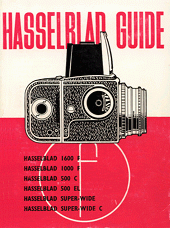 These web-pages have been scanned and converted from the original "Focal Press" publication "The Hasselblad Guide", Third Edition, July 1969. Cameras covered are the Hasselblad 1600F, 1000F, 500C, 500EL, Super-Wide and Super.Wide C. Consequently it does not cover the later models such as the 200/2000F series and the later 500-Series Models. There may be reference to "current" and "discontinued" models. Obviously all Hasselblad cameras described are now long discontinued, but for ease of editing if nothing else, all the original text has been retained.
These web-pages have been scanned and converted from the original "Focal Press" publication "The Hasselblad Guide", Third Edition, July 1969. Cameras covered are the Hasselblad 1600F, 1000F, 500C, 500EL, Super-Wide and Super.Wide C. Consequently it does not cover the later models such as the 200/2000F series and the later 500-Series Models. There may be reference to "current" and "discontinued" models. Obviously all Hasselblad cameras described are now long discontinued, but for ease of editing if nothing else, all the original text has been retained.
The original book was divided into two sections, effectively an overview and a "green pages" section covering specific models in more detail. I've not bothered with a green background to these pages, but hopefully I will have included links where appropriate to the relevant text.
Read the book online (below) or Download the manual in Acrobat PDF format (at the bottom of this page).
|
Hasselblad Guide
How to use the Hasselblad 500C, 500EL, 1600F, 1000F, Super Wide and Super Wide C
Third Edition
By. W.D. Emanuel
The Focal Press
London and New York
|
Table of Contents
|
Compact Complete Correct - The Camera Guide
This is a Camera Guide. It deals with one make of camera, but it is not boosting it. The Camera Guide is a Focal Press publication. It is not sponsored or censored by manufacturers, or dependent on them in any way. The Camera Guide is as scrupulous in fully describing the camera and advising on its use as the very best type of manufacturer's book of instructions. It is, however, more critical than they could be. No Camera Guide will attempt to camouflage the limitations of a camera or make efforts to sell an endless chain of accessories. It is straightforward, practical and devoted to the questions of how to take the best photographs with a particular camera, rather than to praise of it. The Camera Guide is compiled by an authos who has had long experience in handling the equipment in question. it represents at the same time the gist of all available literature collected by the Focal Press Circle of Photographers and filtered through their considered judgment.
Any information regarding cCameras additional to or correcting that publiched in this book will be gratefully received by the publishers, who experts are also willing to answer individual postal enquiries without charge. Letters should be addressed to The Focal Press, 31 Fitzroy Square, London, W.I, and for replies a stamped and addressed envelope must be enclosed.
First Edition : October 1962
Second Edition : February 1966
Third Edition : July 1969
12s. 6d. net / 63p
|
THE HASSELBLAD SYSTEM
The Hasselblad single-lens reflex camera is one of the very few models I this type designed for 2¼ x 2¼ in. size pictures on standard 120 roll film. It is extremely versatile in its application through a system of interchangable film backs for different picture sizes and types of film. Its interchangeable focusing hood permits both waist-level and eye-level reflex focusing. The interchangeable lens system offers wide-angle normal and tele views.
Basically an instrument for all general photographic work, it can be adapted through a wide range of accessories for any specialized field, such as press, portrait, fashion, nature, advertising, architecture, industry, medicine, photocopying, macrophotography and photormicrography.
Despite its versatility, the Hasselblad is essentially simple to handle, even in the hands of the average amateur photographer. The body houses the reflex mirror with ground glass screen, and a simple auxiliary shutter which acts also as capping device for the film while aperture and shutter are open for viewing and focusing. On the front of the body is the bayonet lens mount flange, accepting a range of interchangeable leases (each with its own shutter), and the release button with lock for long time exposures.
The rear of the body takes interchangeable film magazines which click into position with a special locking catch.
The top incorporates the ground glass reflex screen with a Fresnel-type field lens. Above this is a groove accepting a folding finder hood with built-in magnifier for critical focusing. This is interchangeable with a hooded focusing magnifier or an eye~level pentaprism. The base of the body incorporates a plate designed as a quick change tripod attachment slide and features both Continental and international tripod bushes.
One side wall of the body has a shoe for fitting a sports finder, flash contact for the auxiliary shutter, and flash cable bearer. The other side carries the film transport knob which also sets the shutter and which is interchangeable against a trash with built-in exposure meter or quick transport crank. This side also incorporates a quick-release button for the camera back, and shutter position signal. On either side of the camera body is a carrying tamp holder.
The detachable film magazine incorporates its raw, automatic film counter and film-type indicator. Inside the shell it houses a removable film holder with pressure Plate unit. A removable sheath closes the fit,, aperture lighttight. There are three types of magazine, one for 12 exposures 2¼ x 2¼ in. (6 x 6 end.), one for 16 exposures 1 5/8 x 2¼ in. (4 X 6.5 cm.), and one for 16 exposures 1 5/8 x 1 5/8 (4 x 4 cm.) on a standard roll of 120 film.
Several magazines may be used with one camera for different types or speeds of film or different picture sizes.
Built-in safety devices prevent accidental exposures while the magazine sheath is in position, no also lock the shorter release after the last frame ill the magazine has been exposed. For single exposures a sheet adapter can be used.
Ten interchangeable lenses, are available for the Hasselblad with focal lengths ranging from 40 to 500 Each lens has a bayonet filter mount and its own built-in Synchro Compur shutter, which is changed with the lens. The shutter carries an exposure value scale, a manual and spring-loaded automatic pre-selector iris system, and an automatic depth of field indicator. The speeds range from 1 to 1/500 sec. and B, with XM flash synchronization and self timer.
A driving shaft couples the shutter to the camera body and links up with a similar shaft on the camera body itself. Turning the film transport tensions the shutter, opens the diaphragm and opens the shutter blades for focusing and viewing. At the same time the auxiliary shutter in the back of the camera body is closed. On pressing the release, the shatter blades close, the diaphragm closes down to the preselected opening, the auxiliary shutter opens, the mirror flies up and the shutter blades open for the exposure.
The standard lens is the 80-mm. (3 1/8-in.) Zeiss Planar f2.8, seven-element, four component symmetrical anastigmat which combines a wide aperture with excellent correction of the various abberations. It has an angle of view of 52 degrees and a focusing range of 3 ft. to infinity.
A wide range of accessories adapts the Hasselblad camera to almost any specialized field of photography. These include, for close-up work, Proxar lenses, extension bellows, a transparency copy holder, microscope adapter, micro shutter and lens mount adapter for attaching special lenses. A sheet film adapter with single sheet film holder and film cutter are available to permit the use of sensitive materials other than roll film. A magnifying hood, eye-level pentaprism prism sports finder and sports frame barter provide alternative focusing and viewing methods. The rapid winding crank, film transport knob with exposure meter, quick tripod coupling, quick focusing handle, camera grip etc., increase the speed or convenience of operation.
The Hasselblad Super Wide is an extreme wide-angle camera. It can be considered as a lens permanently fixed to a shallow non-reflex body, using the normal Hasselblad roll or sheet film backs. The lens is a 38-mm. (1½ in.) Zeiss Biogon f4.5, an outstanding eight-element, wide-angle anastigmat with a 90 degree angle of view. It focuses from 12 in. to infinity. This is bulb into a Synchro-Compur shutter. The body carries a rapid winding crank, quick coupling tripod base, and release button mounted on top. A ground glass adapter back, grooved to accept the magnifying hood, is available for composing, precision focusing. photo-copying and close-up shots. A brilliant optical finder is provided for hand-held shots.
|
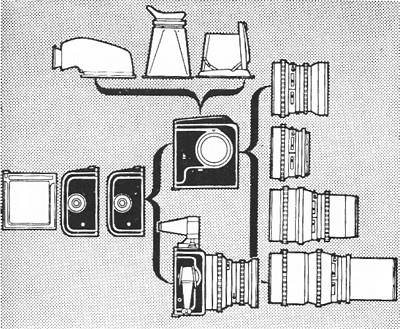 The Hasselblad System
The Hasselblad System
The Hasselblad is part of a comprehensive camera system, built up on the unit principle. The basic components are the camera body, the film cassettes and the alternative body of the Super Wide (shown in black). These are used with a number of interchangable units, covering on the one hand alterrnative lenses complete with shutter units (right), and on the other alternative finder units for waist-level and eye-level viewing (top) as well as roll film magazines and single sheet film cassettes (left). Further accessories include close-up gear such as the extension bellows and extension tubes, various other lense attachements to faciltate focusing, cable releases, etc.
|
Hasselblad Evolution
THE HASSELBLAD 1600F *, introduced in 1948, follows on the whole the description on pages 4-7 but has a focal plane shutter with speeds from 1 sec. to 1/1600 sec., built into the camera body. The lenses therefore are without shutters. The film transport knob is fixed. The standard lens is the 80-mm. Kodak Ektar f2.8 with manual pre-set iris. The camera base has no quick-mounting facility.
THE HASSELBLAD 1000F * replaced the 1600F in 1952. It still has a focal plane shutter, but with speeds from 1 sec. to 1/1000 sec., and is generally improved in precision. Originally it came with the 80-mm. Kodak Ektar f2.8, later on with the 80-mm. Zeiss Tessar f2.8.
THE HASSELBLAD 500C, introduced 1957, follows the description on pages 4-7.
THE HASSELBLAD 500EL, introduced in 1965, is basically a 500C but has a built-in electric motor to advance the film and cock the shutter automatically for remote operation of the camera.
THE HASSELBLAD SUPER WIDE *, introduced in 1954, is similar to the specification on page 7, but has a Compur shutter and film transport knob. The lens has a manual pre-set iris. The camera base has no quick-mounting facility.
THE HASSELBLAD SUPER WIDE C superceded the Super Wide model in 1959 and is as described on page 7.
In the course of the years, minor improvements were made within each model, which do not. however, affect manipulation. Models marked * are now discontinued.
|
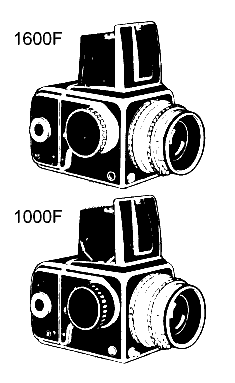 HASSELBLAD EVOLUTION
HASSELBLAD EVOLUTION
The Hasselblad camera evolved along two parallel lines. On the one hand there are the normal models, starting with the 1600F (first introduced in 1948) and followed by the 1000F in 1952. These cameras, with focal plane shutter, were replaced by the 500C in 1957 with underwent minor changes, in particular in the design of the standard waist-level hood. The 500EL, introduced in 1965, is a 500C with built-in electric motor.
The Super Wide series started with the original Super Wide in 1954, which was superseded by a modified model C in 1959.
|
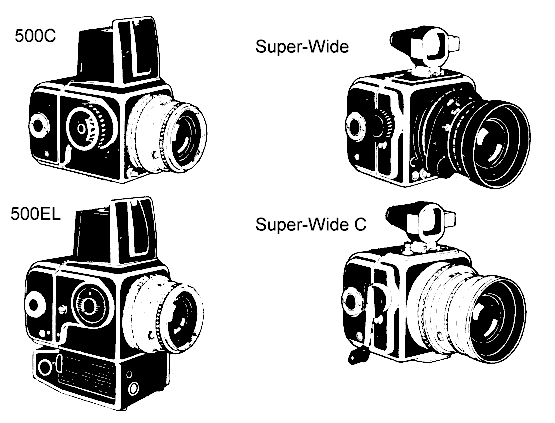
|
The Hasselblad Picture Size
The 2¼ x 2¼ in. film is not a miniature size by modern standards. Contact prints made of these negatives are large enough to be appreciated as proofs, but enlargements are of course more effective. Whilst, however, the 24 x 36 mm. miniature negative needs a 12 times linear enlargement to yield a 12 x 15 in. exhibition print, the 2¼ x 2¼ in. negative produces the same size of print with only 6½ times enlargement. Thus the Hasselblad negative is not as a rule subjected to an extreme degree of enlarging.
The Square Shape
The Hasselblad negative has a square shape. The view of the lens is a circle and this circle is best utilized by the square - but this in itself is a purely technical consideration. Essential, however, from a practical point of view, is the fact that the square, representing the simplest geometrical pattern (next to the circle), lends itself easily to placing and framing almost any subject matter. With the square picture the camera hold is the same for every shot. Should the square shape prove unsatisfactory with a particular subject it is still possible to print only a portion of the negative, without sacrificing more of the subject than a rectangular picture shape would have done from the outset.
|
HANDLING THE HASSELBLAD
In order to simplify the description and handling of the Hasselblad camera without being confused by different features if individual model,, this Guide is divided into a general section hich applies to all Hasselblad models and a section of green pages to cover the individual requirements and differences in handling of each model.
For convenience a symbolic reference system is also used in the general section. Wherever the sign # appears, further details will be found in the camera pages of the green section for each camera. The sign * refers to lens and ** to accessory details in the green section. The appropriate pages are marked accordingly in the bottom left- or right-hand corner.
Holding
Naturally the camera should be held as steady as possible as the slightest camera shake, even if not seen in the negative, will become visible in the enlargement.
There are various ways of holding the camera. The basic method is to carry the camera on its strap-which should be passed round the back' of the neck. Hold the camera in the left hand with the index finger of the left hand on the release button. The right hand remain, free far transporting the film, setting shutter speed, aperture and focus. Pulling the camera down against its strap will help considerably to steady it at the time of exposure.
When the magnifying hood is used, press the eye against the eyepiece. Insert both hands from below through the carrying strap (adjust its length to suit); this provides additional steadying support.
Virtually the same holding position can be adapted when using the camera at eye-level with either the sports frame finder or the pentaprism.
To release the shutter, press the release button with the ball of the index finger. Use finger pressure only, and keep the band and its grip on the camera steady. The actual pressure should be slow and smooth, The slower the exposure time, the smoother must be the release.
For slow exposures in the hand, it is advisable to rest the elbows or at least to lean the body against some support in order to avoid shaking. In this way, 1/15, 1/8 and even¼ see, can be risked without incurring camera shake.
Such a support is also desirable for faster exposures, as various movements take place inside the camera after pressing the release button. A slightly unsteady hold may thus easily lead to blurred pictures
The use of a tripod or other solid support is necessary when taking time exposures and it is also recommended for speeds from 1/15 to 1 sec. It is useful even for normal instantaneous shots (1/30 to 1/125 sec.) where circumstances permit.
Carrying
To he ready for quick action, it is best to carry the camera on its shoulder strap round the neck so that it lies on your chest, lens downwards. Lifting it up then takes a split second.
For convenience and protection, carry the Hasselblad in its ever-ready case. It is then only necessary to open the flap to get the camera ready for use.
The camera neck strap itself goes through the ever-ready case.
Viewing and Focusing
You can view and focus only after the shutter has been wound. This operation brings down the mirror into its viewing position to reflect the image from the lens on to the ground glass screen. So you know that when the image is visible, the film is also advanced for the next shot (the film transport is coupled with the shutter tensioning mechanism).
The image appeals in natural size, free from parallax.. A Fresnel-type field lens ensures even illumination right into the corners of the screen.
The lens is used at full aperture for focusing. This shows up the difference between a perfectly sharp and slightly unsharp image to the greatest degree; at a smaller lens stop it is not so easy to adjust the lens exactly to its sharpest setting. Such critical focusing also leads to emphasis of the main subject by good definition - thereby separating it from its background. This is the first decisive step from the casual snapshot to a real picture. The focusing screen is the most efficient means of photographic collation. Unlike any other viewfinder it presents a two-dimensional, full-size preview of the photograph as it will look later. The man who cannot be taught to "see" photographically by the ground glass of a camera will never learn to do so.
To open the hood, push its catch to the right. The hooding of the finder keeps stray light from the screen, and so makes the images appear brighter. To close the hood first fold down both sides, followed by the back and finally the front.
Although you are likely to hold the camera reasonably level, make sure that vertical and horizontal lines of the picture run parallel to the cross engraved on the screen. You can tilt the camera intentionally, but see that the effect does not look like an accidental tilt.
The picture on the screen appears upright, but reversed left to right. Movements are also reversed left to right; to follow moving subjects you therefore have to turn the camera against the apparent subject movement.
Waist-level and Eye-level Viewing
With the camera held at chest or waist level for reflex viewing you see many popular subjects - children, animals, people sitting down- from a more natural viewpoint than when looking down from eye-level. More natural, that is, for the subject, for the camera gets down automatically to the subject level. Informal portraits, candid studies, can be got quietly and without fuss.
For unobserved shots hold the camera at right-angles, with the lens pointing to the left or light instead of straight ahead. To take pictures over the heads of a crowd or to obtain a higher viewpoint, hold the camera above your head, viewing up into the reflex screen.
The camera is used at eye-level with the pentaprism and the prism sports viewfinders, where the image appears upright and the right way round. These are therefore the finder units to choose when the cameras should be used at eye-level for viewing and focusing, particularly when following moving objects with the camera.
The sports frame finder serves the same purpose as the pentaprism and prism sports finder, but does not permit reflex focusing at the same time. This is therefore primarily intended for sports, landscape, or other distant subjects, or for shots where you pre-focus on a subject that remains at the same distance from the camera.
A separate frame viewfinder to, Sonnar 150 and 250 lenses snaps on the lens hood
Focusing Technique
The best way to arrive at critical definition is to turn the focusing mount of the lens slowly to and fro while observing the subject to be focused on the ground glass. As you turn the mount, the image becomes more and more sharp up to a certain point, beyond which it will again lose definition. At this "beyond" stage, turn the mount back again, narrowing down the degree of movement until you arrive at the point of best definition.
The Hasselblad has a magnifier built into the focusing hood to determine the point of best definition. To bring it into action push the hood opening cath fully to the right. When closing the hood, fold the magnifier back first.
The orthodox way of focusing with the ground glass screen may be adopted for taking photographs of subjects that are fairly stationary. A different method of focusing is required when taking subjects in motion. Set the lens to a distance at which the subject will be in a given moment, or focus at some spot which it actually has to pass and press the release button when the subject is reaching the prefocused point.
With subjects liable to react self-consciously (e.g. children) set the lens to a suitable distance, and then approach the subject, exposing as soon as the screen image appears sharp.
Alternatively, focus at some object which is at the same distance from the camera as the subject, but in a different direction. When you have found the range swing round to press the release button as soon as the subject slip, into the field of view of the finder.
Shooting
Practise the following operations first with the empty camera with its film magazine in position until you can do them practically automatically.
- Wind the film transport. This advances the film and film counter, tensions the shutter, opens the aperture (in C models) and brings down the mirror ready for the next exposure.
- Open reflex hood to focus for a preview of the picture you want to take.
- Set the exposure. Adjust the shutter for the right amount of light for the subject conditions (see page 32).
- Select the aperture-speed combination you want to use; smaller apertures for greater depth of field (page 48) or faster speed to arrest movement (page 47).
- Determine the exact picture area and focus.
- Release the shutter gently.
|
HOLDING AND CARRYING
For eye-level shooting, the pentaprism (above left) fits on top of the camera in place of the waist-level hood. Hold the camera up to the eye, looking directly through the eyepiece at the back. With the sports finder (above right) turn the camera sideways so that the sports finder is on top in its shoe on the side of the camera (above right).
The normal hold consists in supporting the camera round the neck with the carrying strap, and steadying it with the left hand. The left index finger is on the release button, while the right hand focusses the lens. The right hand also operates the winding knob after every exposure.
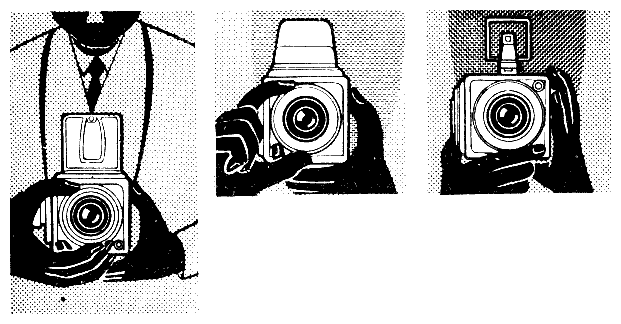
Two special holds for unusual occasions. To shoot over the heads of a crowd, hold the camera upside down above your head and look up into the finder hood (above left). To get unobserved shots of people turn the camera round sideways (above right) so that the lens points past your left arm. You see what is going on by looking down into the finder, although you are facing at right angles to the shooting direction of the camera.
When not actually shooting, let the camera hang on its carrying strap, lens downwards. The strap is held in position on clipping the fitting at the end of the strap over the strap button at each side of the camera body (inset).
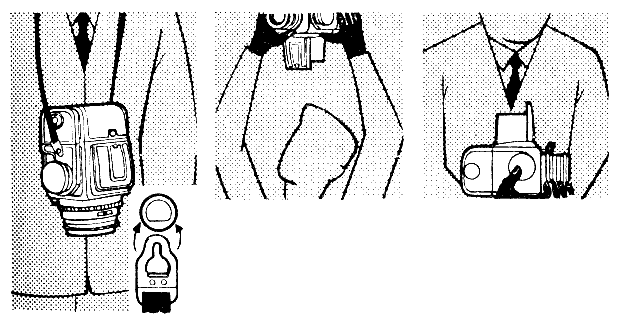
|
THE INTERCHANGEABLE FILM MAGAZINE
One of the most important features of the Hasselblad camera is the interchangeable film magazine. This is the film holder which is loaded and unloaded independently of the rest of the camera. The use of film magazines permits film changing at any time.
Each magazine has a easing of stainless steel. The ends of the case are aluminium, polished and chrome plated to resist wear and scratching. The spool holder is aluminium alloy. The pressure plate is precision turned and has a black anodized surface.
Magazine Models
THE STANDARD MAGAZINE is in two versions - the A12 and the 12. Both take 120 roll film, giving 12 pictures 2¼ x 2¼ in., with automatic stop after 12 exposures. The A12 also has automatic stop at the first frame and can be loaded faster.
THE 16 MAGAZINE takes 16 pictures 1 5/8 x 2¼ in., still on size 120 roll film, but with the picture area masked down. This offers a certain film economy, especially when using colour film. The film counter on the magazine counts exposures up to No. 16. A ground glass screen mask is also supplied with the magazine, with markings to show the limits of the 1 5/8 x 1 5/8 in. super-slide size. This gives a guide to arranging a picture for subsequent trimming down to a miniature slide format for mounting in 2 x 2 in. slide holders.
THE 16S MAGAZINE is similar to the 16 magazine, but the film aperture is masked down to 1 5/8 x 1 5/8 in. A ground glass screen mask is supplied with it. This magazine directly yields transparencies of the correct size for mounting in 2 x 2 in. slide frames.
All these magazines may be used with the '220' film, see page 23.
THE MAGAZINE 70 is designed to take up to 15 ft. of cassette-loaded 70-mm. film for up to seventy 2¼ x 2¼ in. negatives. The magazine is of similar design to the others with film plane markings, film signal, counter and film type indicator. It is intended for the professional, press and also amateur photographer who has to take large numbers of photographs at one sitting.
70-mm. film is supplied in 100 and 300 ft. rolls from which cassettes can be loaded with any length up to 16 ft. Ready loaded cassettes ale also available.
|
THE ROLLFILM MAGAZINE
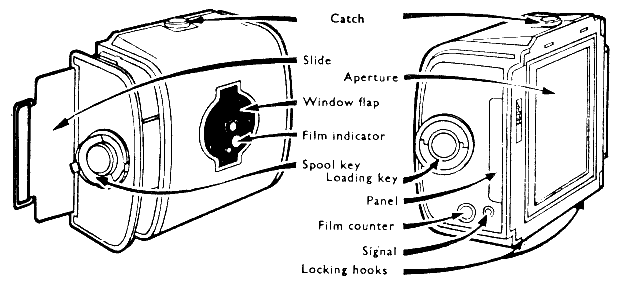 The catch secures the magazine to the camera body. The pullout slide closes the film aperture light tight when the magazine is removed from the body. The window flap opens the rear window for advancing the film to the first exposure. It is fitted with a film type an speed indicator. The spool key unlocks the spool holder for loading. The loading key serves to windo up the film to the first exposure. The panel carries identifying marks for the number of exposures available with the magazine, and also a film plane mark. The film counter shows the number of frames exposed, and is coupled with the transport machanism of the camera. The signal indicates whether the film in the film plane has been exposed. The locking hooks engage the bottom of the camera body when attaching the magazine.
The catch secures the magazine to the camera body. The pullout slide closes the film aperture light tight when the magazine is removed from the body. The window flap opens the rear window for advancing the film to the first exposure. It is fitted with a film type an speed indicator. The spool key unlocks the spool holder for loading. The loading key serves to windo up the film to the first exposure. The panel carries identifying marks for the number of exposures available with the magazine, and also a film plane mark. The film counter shows the number of frames exposed, and is coupled with the transport machanism of the camera. The signal indicates whether the film in the film plane has been exposed. The locking hooks engage the bottom of the camera body when attaching the magazine.
 Fitting the magazine. Check that the signal on the camera and magazine correspond (left), then hook the bottom of the magazine to the camera body (centre left), push the magazine against the camera back (centre), and secure the catch (centre right). Then pull out the slide (right); the camera is now ready to shoot.
Fitting the magazine. Check that the signal on the camera and magazine correspond (left), then hook the bottom of the magazine to the camera body (centre left), push the magazine against the camera back (centre), and secure the catch (centre right). Then pull out the slide (right); the camera is now ready to shoot.
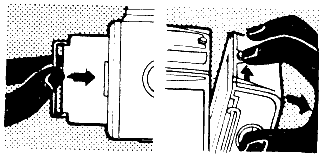 Removing the magazine. First always insert the slide to close the film aperture light-tight (right), then press the catch to release the magazine from the body (far right).
Removing the magazine. First always insert the slide to close the film aperture light-tight (right), then press the catch to release the magazine from the body (far right).
|
Fitting to, and Removal from, the Camera
Let us start with the magazine attached to the camera.
Before the magazine can be removed, the sheath has to be in place on the front of the magazine, protecting any film in it from being exposed to the light. As a safety feature, the magazine cannot be removed from the camera body until the sheath is completely inserted into the magazine. To insert the sheath slide it into the slot on top and push down fully. The bent-over part of the sheath (which acts as a finger hold) should always be towards the front of the magazine for easier loading.
To remove the magazine, press the catch on the top to the right, let the magazine drop back, and lift it out from the two catches on the camera body.
When a magazine is freshly loaded and the automatic counter set to No. 1, the signal on the light is white, indicating that an unexposed frame is in position in the magazine.
Before you attach the magazine to the camera, the corresponding signal on the right-hand side of the body (behind and before the transport knob) should also be white, indicating that the film transport has been wound and the camera, too, is ready for exposure. If the signal on the camera is red, simply wind the transport knob before attaching the magazine.
If the last frame still in the film aperture of the magazine is already exposed, the magazine signal is red. The camera signal then also has to be red before you attach the magazine. If the camera signal should be white, simply release the shutter to make the signs colours match. This boils down to the rule that both signals have to indicate the same colour (either red or white) before the magazine is attached.
To attach the magazine to the camera, lower its front edge into the two hooks at the rear base of the camera, and push the magazine against the camera body while pressing its locking catch to the right. Once the magazine makes full contact with the camera body, move the catch to the left. After pulling out the sheath, the camera is ready to use.
|
Loading the Rollfilm Magazine
- Remove the spool holder. First release the catch in the centre of the left-hand side (opposite to the side of the signal) and turn it anti-clockwise. Pull out the spool holder.
- Prepare the spool holder by turning the spool holder catch clockwise to open the film clamp and open up both spool holder arms.
- Load the film. Insert the empty take-up spool into the holder with the milled knob. Place the full film spool into the opposite holder. Remove the seal and pull out approximately 4 in. of paper, the black side of the paper facing you. (The spool must be inserted so that the backing paper comes off from underneath.) Keep the thumb pressed against the spool to prevent the film from unwinding itself. Draw the free paper across the front of the pressure plate but under the film clamp. Hold the paper in position by turning the spool holder catch anti-clockwise. Now fix the paper end into the slot of the take-up spool. Take up the slack by turning the milled knob protruding from the take-up spool chamber.
- Insert the loaded spool holder into the magazine shell (make sure that its sheath is in position), and turn the release catch clockwise. This has the double action of locking the spool holder in position and releasing the clamped-down paper.
- Set the first exposure. Open the film window cover in the back of the magazine and turn the winding knob until No. 1 appears in the rear window. The winding key is the key in the right-hand side of the magazine, i.e. the same side as the signal window and the film counter window. Now turn the film winder anti-clockwise as far as it will go. Always keep the film window cover closed - except when getting the magazine ready for the first exposure.
This causes No. 1 to appear in the automatic film counter window on the winder side of the magazine. Always set the counter window to No. 1 immediately; if this is overlooked you will get uneven spacing between the individual negatives and possibly lose the last exposure.
- Set the film indicator. This is advisable even if only one magazine is used, and becomes essential when you work with several types of film. The film indicator is on the back of the magazine. On it you can set the speed of the film in ASA and DIN (white figures on black) and also the type of material. The latter you set in the cut-out by turning the milled centre button.
- The various symbols are as follows:
- red star with + sign = daylight colour reversal film;
- red star with - sign = daylight or universal colour negative film;
- red bulb with - sign = artificial light colour reversal film;
- red bulb with - sign = artificial light colour negative film;
- divided black and white circle = black-and-white film.
- Attach the loaded magazine to the camera (see page 18). However, there is no need to remove the magazine from the camera at all for reloading, as all the steps are equally possible while the magazine is on the camera.
The metal panel indicating the film plane on the outside of the magazine (a circle with a vertical line through it) may be used for pencil notes, e.g. exposure, developing or subject data. The notes can be removed with a damp cloth or india rubber.
Unloading the Rollfilm Magazine
After all exposures have been made, the shutter release on the camera is automatically blocked. So you cannot accidentally take pictures without film. The film counter window in the side of the magazine always shows the number of exposures. When this reaches No. 12 (or No. 16 with the 16-exposure magazine), unload the film. There is no need to remove the magazine from the camera for unloading.
- Wind off the film end. Turn the winding key until the paper end disappears in the film window in the back of the magazine (open the cover to check) and the film completely wound on to the take-up spool.
- Remove the spool holder as described for loading.
- Remove the full spool of film from the spool holder. Seal the end down to prevent accidental unrolling.
- Re-insert the spool holder into the magazine (as described for loading, step No. 4), or reload with film.
Early Magazines
Magazines of serial numbers below 20000 are of a somewhat hat different construction and will not fit the Hasselblad 500C or Super Wide C. The current magazines will fit all models
These early magazines can be recognized by the exposure counter window which is below the film transport key. On the current ones the film counter is close to the signal window. Also the film window cover on the back has no film type and speed indicator.
Early magazines have no automatic release lock to prevent exposures beyond the last film frame.
The only difference in handling arises after turning the film transport key to bring No. 1 into the film window in the back of the magazine. On the early models the key is then turned anti clockwise a number of turns (in place of a quarter turn as on the current model) until it comes to a definite stop, when No. 1 appears in the film counter window on the side.
Changing Partly Exposed Magazines
One of the main features of the Hasselblad system is the ease of changing from one magazine to another after any number of exposures. The procedure is as follows.
- Turn the film transport of the camera. This tensions the shutter and advances the film, setting both signals to white. (While not essential, this is a strongly recommended procedure.)
- Insert the sheath into the magazine.
- Remove the magazine from the camera (see page 18).
- Attach the alternative magazine (see page 18).
Deliberate Double Exposures
While the construction of the camera automatically prevents two exposures it one film frame, deliberate double exposures are possible. The procedure, after the first exposure, is as follows:
- Remove the magazine.
- Tension the shutter without magazine attached to the camera.
- Attach the magazine again.
- Release the shutter.
Quick Winding Crank
This special crank for film magazines is attached to the loading key of the magazine and permits quick winding forward to the first frame and equally on winding off film after the last exposure.
|
LOADING
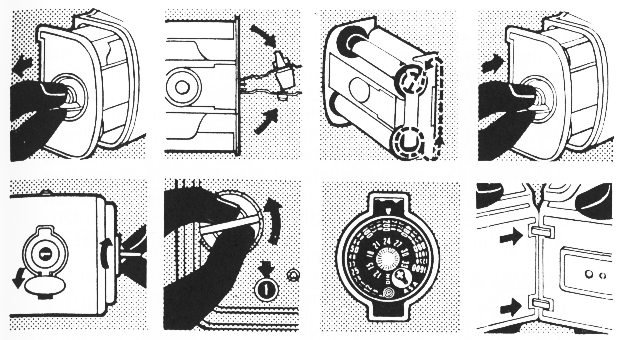 Top row: Unlock the spool holder key (left) and pull out the spool holder. Open the spool holder arms (centre left), insert the full film spool and thread the backing paper around to the empty take-up spool (centre right). Insert the loaded spool holder into the magazine and lock (right).
Top row: Unlock the spool holder key (left) and pull out the spool holder. Open the spool holder arms (centre left), insert the full film spool and thread the backing paper around to the empty take-up spool (centre right). Insert the loaded spool holder into the magazine and lock (right).
Lower row: Wind the loading key to bring No. 1 into the centre of the film window at the back (left), then turn the key anti-clockwise and fold down (centre left). Set the film indicator in the rear flap (centre right). The magazine is then ready for attaching to the camera (right).
UNLOADING
 Unloading. Wind off the end of the backing paper with the loading key (left), then remove the spool holder by unlocking the spool key and withdrawing the holder (centre). Finally remove the full film spool and seal (right).
Unloading. Wind off the end of the backing paper with the loading key (left), then remove the spool holder by unlocking the spool key and withdrawing the holder (centre). Finally remove the full film spool and seal (right).
|
220 Film
Primarily designed for the professional user, 220 film permits 24 exposures 2¼ x 2¼ in. square in the standard Hasselblad magazine observing the following points:
As the new 220 film is without backing paper the light leaking through the film window must be shut out by a light-tight plug which is fitted on to the film window, from inside the magazine, with the number "220" facing outwards or by fixing black tape across the film window. The 220 film has an arrow going across the first paper section; it has no numbering but there is a dotted line about 6 in. before the crosswise arrow. To obtain the most even spacing between negative frames the appropriate instructions (below) should be used in accordance with the serial number of the magazine employed.
Magazine Serial No. 001-19999
- Thread the film in the usual manner on to the Hasselblad spool-holder. The protecting paper is drawn forward so that the dotted line comes to the centre of the receiving spool.
- After the spool-holder is inserted in the magazine, set the exposure-counter at 1 .
- Wind the film forwards 7 complete turns (14 half-turns).
- Expose 12 frames (no stop).
- Reset the exposure counter to 1.
- Expose another 12 frames (no stop).
Magazine Serial No. 20000-64399
- Thread the film in the usual manner on to the Hasselblad spool holder. The protecting paper is drawn forward so that the dotted line comes to the centre of the receiving spool.
- After the spool-holder is inserted in the magazine, set the exposure-counter to 1.
- Wind the film forwards 10 complete turns (20 half-turns) or until the frame number 8 begins to appear in the exposure-counter window.
- Reset the exposure-counter to 1.
- Expose 12 frames (until stop).
- Reset the exposure-counter to 1.
- Expose another 12 frames (until stop).
Magazine Serial No: 64400
- Thread the film in the usual manner on to the Hasselblad spool-holder. The protecting paper drawn forward so that the dotted line comes to the centre of the receiving spool.
- After the spool-holder is inserted in the magazine, set the exposure counter to 1.
- Wind the film forwards 9 complete turns (18 half-turns) or until the frame number 7 appears in the exposure-counter window.
- Reset the exposure-counter to 1.
- Expose 12 frames (until stop).
- Reset the exposure-counter to 1.
- Expose another 12 frames (until stop).
Loading in accordance with the above gives relatively good spacing results throughout. In older magazines, up to Serial No. 64399 it must be expected that certain frames, especially in the film-section 8-12 might overlap by a few millimeters. But spacing is better in the later magazines. Magazines 16 and 16S which have manufacturing numbers below 204.200 should he loaded in accordance with the instructions according to magazines of Serial Nos. 20000- from manufacturing number 204.200 and above as for Serial Nos. 64400 and above; reset the exposure-counter after In exposures have been made.
|
FILMS AND FILTERS
The film used in the Hasselblad is the standard size 120 roll film. It gives 12 exposures 2¼ x 2¼ in. (6 x 6 cm.) in the standard film magazine. In the special 16-exposure magazine the same film produces 16 pictures 1 5/8 x 2¼ in. (4.5 X 6 cm.) and in the 16S magazine it is used for 16 pictures 2 x 2 in. (5 x 5 cm.). For use of '220' film see page 23.
The sheet film adapter permits single exposures on sheet film (**). A wide range of emulsions is available.
Black-and-white Film
This produces a negative in which the colours and brightness range of the subject are translated into black and white. From it, prints or enlargements on paper or black-and-white transparencies can be made.
The black-and-white film used normally is panchromatic; that means that it is sensitive to all colours. A few emulsions still on the market are orthochromatic, i.e., not sensitive to red. There is a choice of several types differing mainly on sensitivity as well as certain other characteristics.
SLOW FILMS are of low sensitivity, requiring comparatively great exposure. Their main advantage is the extremely fine grain, permitting a high degree of enlargement without its granular structure becoming unpleasantly visible. Such films also yield images of the greatest sharpness. On the other hand, these slow films are not very suitable for coping with fast movement in other than exceptionally good lighting, nor for general work in poor light. Such films are rated at 40-80 ASA or 17-20 DIN.
MEDIUM SPEED FILMS still yield a reasonably fine grain with good gradation, They are the most suitable material for all-round photography. other than in poor light. These films are rated at 100-160 ASA or 21-23 DIN.
FAST FILMS with somewhat coarser grain (still acceptable for reasonable degrees of enlargement) will cope with most light conditions including poor light and interiors in favourable conditions. This is the right film for the photographer who wants to be prepared for the unusual, to arrest fast movement with high shutter speeds, and to take shots in poor light. The speed are 200-400 ASA or 24-27 DIN.
ULTRA FAST FILMS are primarily intended for highspeed sports shots in dull weather, interior snapshots in poor light, night photography and ill-lit stage pictures. These films are specialist types for conditions where normal materials are totally inadequate. The high speed is achieved at some cost in definition and graininess. Speed ratings range from 500-1,300 ASA or 28-32 DIN.
The above speed figures are based on the latest ASA Standard for film speeds (and on the BC and DIN Standards under revision). These figures, when used on the exposure meter, give minimum correct exposures, to make the most of the versatility of the film and of the image quality. They are also the figures quoted by most film manufacturers. Sometimes films are, however, still rated according to earlier standards which, in effect, incorporated a generous safety factor against underexposure - by the simple process of overexposing films about 100 per cent (well within the exposure latitude of most black-and-white films). So you may come across films apparently only half as fast as others of similar type, because of this difference in ratings. The table on page 68 indicates the current fiim speeds to be used with the exposure meter, even if the film packing gives a lower rating.
This applies to black-and-white negative materials only; speed rating methods have not changed for colour films.
There is a wide range of different makes of films in all speeds on the market. Their characteristics, apart from speed, vary slightly from make to make. It is safe to say that all well-known brands are reliable and good. The best film is the one you are used to. Professional photographers and advanced amateurs may find one or the other characteristic of a particular make, i.e., its gradation, granular structure, acutance etc., of particular value for specific jobs.
|
FILM SPEED, CONTRAST, GRAIN, RESOLVING POWER
Generally speaking, low speed goes with greatest contrast, finest grain, and highest resolving power, and vice versa. The film speed in the top row points to the corresponding contrast, grain and resolving power. The contrast row (from left to right) shows how high contrast becomes medium and low with the faster films. The grain row shows (from left to right) how fine grain becomes progressivly coarser with increasing speed, while the resolving power row indicates the gradual decrease in maximum resolution with the fastest films. The bottom row indicates the type of subject for which films of the various speeds are best; copying (special document films), general views and pictures of people (fine grain and medium speeds films), high-speed action (high-speed films) and poor light conditions (ultra-speed films).
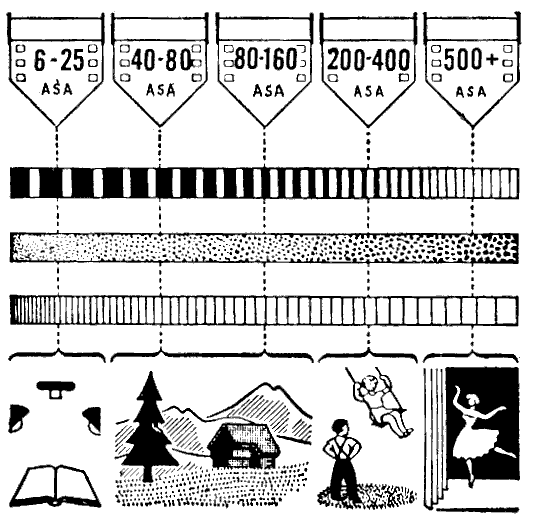
|
Colour Film
These films produce an image in colour after appropriate processing, corresponding directly or indirectly to the natural colours of the subject. From the practical point of view, colour film is as easy to use as black-and-white film, but needs a little more care in exposure. Processing is more complex and is often carried out by the film maker or specially appointed processing laboratories.
There are two types of colour film: reversal and negative.
Colour, Reversal Film
This produces a colour transparency on the actual film exposed in the camera. This transparency held up to the light shows a positive image with all parts of the subject in their original colours. It can be viewed in a suitable transparency viewer with a magnifier or it can be projected in a slide projector to give a large picture on a screen.
There is little doubt that the projected image is the most natural and best for showing colour.
Although the colour transparency is an end product. it can still be used to make:
(a) duplicate positive colour transparencies,
(b) a black-and-white negative which can then be used to produce black-and-white prints or enlargements,
(c) a colour negative for making colour prints and enlargemerits, as from colour negative film (described below),
(d) direct colour enlargements on colour reversal paper.
Colour prints on paper invariably show loss of colour quality as compared wish the original positive transparency.
For correct colour rendering, colour reversal films have to be carefully matched to the light by which they are to be exposed. Accordingly, most makes are available in two or more of the following types:
(a) daylight colour film which will give correct colour reproduction in daylight or with blue-tinted flash bulbs,
(b) artificial light type colour film which will give correct rendering by photoflood or tungsten illumination,
(c) flash type colour film (type F) which will give correct rendering with the normal clear flash bulbs.
Colour films made for one kind of light may often be used under different light conditions with the aid of a conversion filter as recommended by the manufacturer.
Different makes of colour film may yield transparencies of a slightly different characteristic colour quality, colour saturation and colour contrast. Which you prefer is very much a matter of personal taste.
Colour Negative Film
On processing, this produces a colour negative which shows a negative image of the subject in its complementary colours, e.g, blue appears yellow. red appears blue-green and so on. These colours may sometimes be hidden under an overall orange or reddish tint.
The main purpose of the colour negative is the production of colour prints on paper. The quality is generally higher than that obtained from a positive transparency.
From the colour negative you can make.
(a) any number of colour prints in varying sizes,
(b) direct black-and-white prints or enlargements, in the same way as from a black-and-white negative,
(c) positive colour transparencies for viewing or projection.
Colour negative films are mostly suitable for exposure by any type of light, e.g. daylight, flash or photofloods. The necessary adjustment of the colour rendering is carried out during the printing stage. Manufacturers sometimes recommend conversion filters even with colour negative films. These mainly serve to simplify the subsequent correction heeded in printing.
Colour Film Speeds
The majority of colour films, reversal and negative, are rated between 25 and 64 ASA or 15 to 19 DIN, corresponding to a slow to medium speed for black-and-white material. A few films go up to 160 ASA or more for poor light conditions.
As with black-and-white films the slower types tend to yield improved image detail, especially with negative colour film, while the fastest emulsions may show slightly reduced colour saturation and image sharpness.
The Choice of Colour Film
Making your choice between colour reversal or negative film (in spite of the various uses that can be made of either type of material) remains an individual question.
First there is the way you want to see the result, as a colour print or as a colour transparency. The print has no doubt much to commend itself. It is easily shown, stored and carried about. The transparency calls for the aid of a viewer or projector.
Next, the cost of a colour print is about three times that of the transparency. This may at times be mitigated by the fact that from unsuitable negatives no colour prints need or can be made. The transparency user, however, has additional outlay in the form of a viewer or projector with screen (in most cases both).
A final point to consider is the quality. The transparency will record each colour and its brilliance in full. Held to the light or projected on a screen, the brightness range, which may be 100 : 1, is fully or almost fully retained. It shows colours brilliant with great depth and realism. The colour print can at its best only reflect four-fifths of the light failing on it and even the darkest tones reflect about one-twentieth to one-tenth, so that the full range is no more than 16 : 1. While the colour print is, by necessity, duller than the transparency. it s only fair to say that the eye soon adjusts itself to the reduced brightness range, and subjects without great contrasts will be very satisfying.
From the point of view of convenience, reversal film has the advantage that it directly gives finished colour pictures of high quality and is still capable of producing colour prints.
For the maximum versatility and control in print making, however negative film is superior.
|
Filters for Black-and-White Film
By its nature, a black-and-white film can only translate colour values of the subject into tones of lighter or darker grey. Mostly these correspond fairly closely to the brightness of the colours, but do not, of course, differentiate between them. In certain cases the difference between the brightness of two colours may be so slight that both record in almost the same tone of grey.
There a filter helps by modifying the depth of one or the other colour, and so making it show up lighter or darker than it would normally.
The commonest example is the blue sky in a landscape, with white clouds. The blue is so brilliant (and the film is often excessively sensitive to it) that the clouds do not show up against it. By putting a yellow filter in front of the camera lens we can subdue or "holdback" the blue, so making it record darker in the final print. We can even go further and over-emphasize the effect progressively with an orange or red fitter; these darken the blue so much that the sky looks almost black for a really dramatic effect.
The same considerations hold for other filter effects. For instance, the film renders a red rose in the same tone or grey as the green leaves of the rose bush. With the colour contrast gone, the rose disappears in its surroundings. A green filter makes the rose darker and the leaves lighter; conversely, a red fitter will show up the rose as light against dark foliage. Scientifically, both filters falsify the tone rendering, but produce a more acceptable pictorial result.
In all these cases a filter lightens objects of its own colour, and darkens objects of its complementary colour. Apart from isolated instances in pictorial photography, such contrast control is very valuable in copying and scientific work (e.g., photomicrography).
All filters cut out some part of the light and thus, as a compensation, an increase in exposure time is necessary when using them. This is stated on most filters in the form of a filter factor indicating by how much (e.g., 2 times, 3 times) the exposure must be increased with that filter. The factors are approximate for they depend not only on the nature of the filter but also on the exact colour sensitivity of the film and on the colour of the prevailing light.
With orthochromatic films the scope for control with filters is more limited, since the film is insensitive to the orange and red band of the spectrum Hence there is no point in controlling tones by blue or green filters, and no possibility of doing so by red and orange ones. Only yellow filters are of use with ortho films.
|
INDUSTRIAL SHOTS
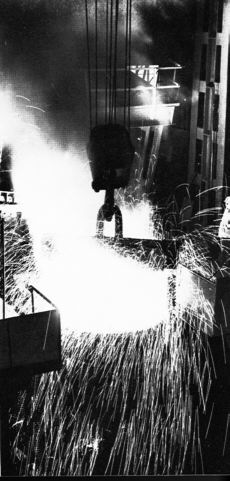 INDUSTRIAL SHOTS like this picture taken in a steel works, prove the versatility of the Hasselblad. Although this utilizes only a part of the film area, the wide angle of view to be covered from top to bottom makes the Hasselblad Super Wide particularly useful. All the prevailing light comes from the glowing steel and the sparks; this requires a comparatively slow shutter speed, which however adds a touch of deliberate blur by recording the flying sparks as lines of light.
INDUSTRIAL SHOTS like this picture taken in a steel works, prove the versatility of the Hasselblad. Although this utilizes only a part of the film area, the wide angle of view to be covered from top to bottom makes the Hasselblad Super Wide particularly useful. All the prevailing light comes from the glowing steel and the sparks; this requires a comparatively slow shutter speed, which however adds a touch of deliberate blur by recording the flying sparks as lines of light.
|
PORTRAITURE and ADVERTISING PHOTOGRAPHY
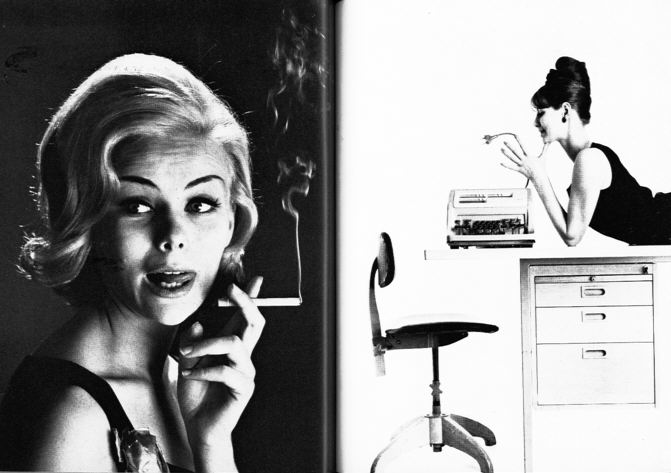
PORTRAITURE (left) and advertising photography (right) are typical of the versatiltity of the Hasselblad in commercial work. The view on the reflex screen permits judging of the exact lighting effect - whether the aim is to bring out the wisps of cigarette smoke (left) or the more factual and almost shadowless illumination for the girl admiiring her electric type writer (right)
|
SPORTS
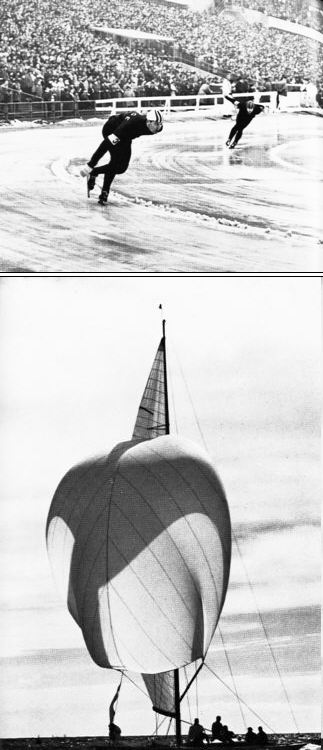 WITH SPORTS and action subjects, especially where it is not easy to get close, the longer focal lenghts are useful. The shot of the skating race (above) was taken with the 500 mm. Tele Tessar f 8 from a viewpoint in the stands. For sailing pictures (opposite) the long reach of the tele lenses enables what would be otherwise a pin-point on the horizon to fill the frame - TAGE SKAR.
WITH SPORTS and action subjects, especially where it is not easy to get close, the longer focal lenghts are useful. The shot of the skating race (above) was taken with the 500 mm. Tele Tessar f 8 from a viewpoint in the stands. For sailing pictures (opposite) the long reach of the tele lenses enables what would be otherwise a pin-point on the horizon to fill the frame - TAGE SKAR.
|
WILD LIFE
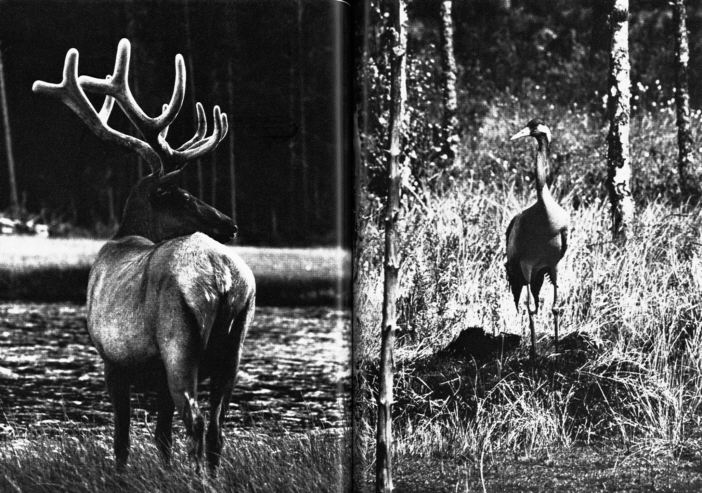
WILD LIFE of shy animals like the elk (left) and rare birds (right) needs a very cautious approach. Usually that also involves shooting from great distances - again with the long-focus lenses up to the 500 mm. Tele-Tessar - L.L.E. RUE and V. HASSELBLAD.
|
CLOSE-UPS
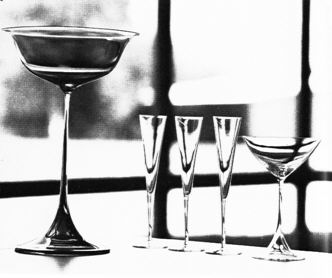 CLOSE-UPS are equally jobs within the province of the commercial and advertising photographer. An arrangement of glassware like this (above) would probably require only a low power Proxar supplementary lens; more elaborate accessoiries are available for macro-photography - TAGE SKAR
CLOSE-UPS are equally jobs within the province of the commercial and advertising photographer. An arrangement of glassware like this (above) would probably require only a low power Proxar supplementary lens; more elaborate accessoiries are available for macro-photography - TAGE SKAR
|
Filters for Colour Film
The normal yellow, orange and other filters for black-and-white film must never be used with colour films, as they would give the colour picture a strong overall colour tint.
In daylight and with daylight type film, only two filters are ever required. One is a haze filter, almost colourless but for a slight straw tinge. It is usefully employed on hazy days and in high altitudes to avoid excessive bluishness of the colour picture, especially with distant landscapes, seascapes and near water. This filter does not call for any change in exposure. On dull days a skylight filter compensates for the excessive coldness of the colour rendering
Either filter is also useful for colour photography with electronic flash as it produces somewhat warmer tones.
Light balancing filters are used if a colour film balanced for one type of light should be used in another type of light.
The Polarizing Filter
There are times when the judicious use of reflections will enhance the pictorial effect of the picture, but they are also frequently obtrusive and undesirable . Thus highly-polished subjects are difficult to illuminate successfully so as to obtain a true photographic rendering, since they will reflect too much light and spoil the reproduction with a glare which obscures the detail. This difficulty can be overcome by the use of the polarizing screen.
It has the special property of suppressing so-called "polarized" light. Light reflections from glass, china, enamel, polished wooden surfaces, water, to a large extent are polarized and can, therefore, be almost extinguished by placing the polarizing filter in the proper position over the lens. This screen will prove particularly useful when taking shop windows, literature, wet objects, etc.
The effect of the polarizing tiller depends on its orientation in front of the lens, and changes as you rotate the filter. The Hasselblad is ideal for observing this. Simply mount the filter on the lens and rotate it in its mount while watching the image on the viewing screen. As the polarizing filter is slightly tinted, the exposure time should be increased, the factor being about two times (= -1 exposure value).
|
EXPOSURE
Exposure means - to expose the film in your camera to light. The dose of light any film needs to produce the right sort of image depends on how sensitive that film is to light. A fast film is more sensitive than a slow film.
Once your choice of film is settles, the basic condition of exposure is settled with it. You are now left with the problem of scaling the light you find in front of your camera to the amount your film needs.
Your job is to judge the light reflected from the subject you are about to photograph. Your grandfather as an amateur photographer used to take into account his geographical position, the time of year, the hour of the day, the state of the sky as well as the tone of the subject itself, and by so adding one thing to another to size up the light reflected from the subject. The experienced professional, of course, hardly ever worked that way. He just had a look and he knew.
Today a light meter or exposure meter does the same for any photographer. It takes a look, it measures the light and it lets you know.
In fact, it does more than that. It translates the light measured straight into terms of photographic exposure. It does so by presenting you with the choice of aperture numbers and shutter speeds, sorting them out in pairs.
Aperture and Speed
The aperture number or f-stop controls the amount of light allowed to enter through the lens. These numbers run in a series: 2.8 - 4 - 5.6 - 8 - 11 - 16 - 22; each stop number lets through half the light of the next lower number (next larger stop).
The shutter speed controls the lenght of time for which the lens is kept open to light. Shutter sped figures represent fractions of a second: 2 =½ second, 4 =¼ second ... 500 = 1/500 second.
The actual exposure is a product of these two: "how much" and "how long". A large amount of light striking the film for a short time may produce an image similar to that produced by a small amount of light striking the film for a long time. Hence the free choice from a series of balanced aperture-shutter combinations offered by your exposure meter: more or less open apertures paired with more or less quick shutter speeds and more of less stopped down apertures paired with more of less slow shutter speeds.
The recent Hasselblad cameras combine these pairs, made up of aperture stops and shutter speeds, into single figures which are then called exposure values or ligth values. Once you set the exposure value suggested by the exposure meter both the aperture and the shutter speed move up and down in step against each other, and so keep the resulting exposure right at every combination.
Choosing the Combination
But whether you work out the right exposure from an elaborate table or chart;
whether you are presented with a series of pairs of aperture figures and shutter speeds;
whether these pairs are summed up in a series of single exposure values;
whether you just set the exposure to the point shown by the needle in your meter;
you still have one decision to face: which aperture-shutter combination to choose for any given shot. Paradoxically enough, they all are right and yet one is better than the other.
Why should it be so?
Because both the aperture and the shutter also have secondary functions and effect.
The aperture not only controls the amount of light that is allowed to pass the lens - it also has a bearing on how much of the image will be sharp.
The shutter, in controlling the lenght of time for which the light strikes the film, will inevitably record any movement during that time as a slight or grater blur.
So you are left with three things to think of:
- How fast is the action you want to catch?
- How much of the scene in front I the lens has to be sharp?
- Is the light good enough for either?
If there is fast action, you have to choose and pre-set an appropriately fast shutter speed (page 49) and then pair it with the stop which is right by your meter.
If the scene is to be sharp from a point close to the lens to some other point well away from it, you should choose the stop that will yield the necessary depth of field (page 48) and then pair it with the shutter speed agreed by your meter for correct exposure.
If the light is very poor, the chances are that you may not be able to cope with either extremely fast or particularly deep subjects.
Yet your choice in putting shutter speed or depth of field first should still be governed by what you value most about the picture you propose to take.
Exposure nowadays is no problem at all. You can arrive at the right exposure by guessing it, or measuring it. But to hit it off in such a way that it will produce the picture you want is still a matter of intelligent judgment.
|
EXPOSURE VALUES
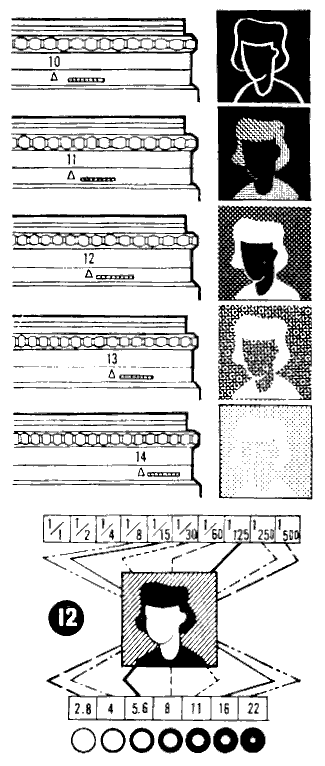 The exposure value system works by assigning a single setting, one of a series of plain numbers, to the exposure. A low exposure value corresponds to a great exposure, higher exposure values corresponds to decreased exposures. Thus if an exposure value of 12 yields a correctly exposed negative, setting of 10 or 11 yield over-exposed negatives, settings of 13 or 14 under-exposed ones. Every exposure value setting yields double the exposure (twice as much light reaching the film) of the next higher value, and half the exposure obtained with the next lower value. Intermediate settings are also possible.
The exposure value system works by assigning a single setting, one of a series of plain numbers, to the exposure. A low exposure value corresponds to a great exposure, higher exposure values corresponds to decreased exposures. Thus if an exposure value of 12 yields a correctly exposed negative, setting of 10 or 11 yield over-exposed negatives, settings of 13 or 14 under-exposed ones. Every exposure value setting yields double the exposure (twice as much light reaching the film) of the next higher value, and half the exposure obtained with the next lower value. Intermediate settings are also possible.
On Hasselblad lenses with exposure value scale the exposure values are marked and set on the shutter rim.
Any given exposure value corresponds to a seris of aperture and shutter speed combinations, each combination yielding the same exposure. Thus an exposure value of 12 would cover settings of½50 second at f4, 1/125 second at f5.6, 1/60 second at f8, and so on. The aperture and speed controls of the exposure value shutter are cross-coupled so that setting a slower shutter speed at the same time stops down the lens accordingly, and setting a large aperture in turn adjusts the shutter speed to keep the exposure constant.
|
Time Exposures
When the light is very weak, especially when you have to use a small stop, even the slowest shutter speed of 1 sec. may be too short. In that case, you need time exposures. Set the shutter to B and press the release button. The shutter now remains open until you let go of the release button.
For such time exposures, the camera must be mounted on a firm support such as a tripod
It is safest to release the shutter with the help of a cable release to avoid shaking the camera. This release screws into the bush of the cable release socket.
For long time exposures, where the shutter is to remain open for longer than you can conveniently keep the release depressed, use the time lock or cable release on the camera.
The Self-timer
All lenses of Hasselblad 500C and Super Wide C have shutters which incorporate a delayed action release or selftimer. When the release is pressed down with the delayed action in operation, the shutter goes off after 8½ seconds and you have time to take your own picture. The camera must, of course, be mounted on a tripod.
|
Using an Exposure Meter
To get the best results an exposure meter has to be used intelligently. This may look like a contradiction, since we have already said that it is an accurate light measuring instrument. But light from all parts of the subject - highlights, shadows and middle tones - falls on the meter, so the reading it gives us is an average one for the whole subject area.
Meters are scaled to suit typically average subjects - i.e. subjects with average areas of light, dark and middle tones. So if you point the meter at a subject of this kind, the exposure reading will be correct.
But if the subject is not average - if there are large highlight areas and little shadow, or large shadow areas with few highlights - then you have to modify the exposure reading to obtain the best results.
So there is more to using a meter than just pointing it at the subject and accepting without question the reading indicated.
The usual method of using a meter is to point it directly at the subject. This gives the correct exposure reading provided the subject has an average mixture of highlights, shadows and middle tones. But if there is a large bright area, or a large dark area, the best method is to go near to the main subject and take a close-up reading. For example, if the subject is a figure against a white or dark background, by going closer you will reduce the amount of background affecting the meter and therefore get a reading in terms of a more average subject, which is what you want.
For some subjects you can take a reading from really close up, aiming the meter at the part of the subject that you want to make sure has optimum exposure. For instance many photographers take a close-up reading of the sitter's face in portraiture out-of-doors you can take the reading from the back of your hand instead of going up to the subject.
If you cannot go close up to a subject that needs a close-up reading, then try to find something near at hand that is similar in tone to the subject, and take a reading from this.
When taking readings of general scenes including a good deal of sky, you have to tilt the meter down slightly to reduce the area of sky "seen" by the meter. The sky is a bright highlight, and by tipping the meter down to exclude some of it, the subject becomes "average" in tone range.
Open views, such as distant landscapes, usually have very light shadows, so you can give a shorter exposure than the meter indicates. It is usual to give half the exposure - i.e. use double the shutter speed, or use one stop smaller.
INCIDENT LIGHT MEASUREMENT
Another method of assessing exposure is to measure the strength of the light falling on the subject instead of that reflected by it. But if you point the meter straight at the light you get a a much higher reading than if you point it at the subject. So the light has to be cut down for the meter to indicate the correct exposure. This is done by fitting a white diffuser supplied with most meters over the cell of the meter which is designed to reduce the light just the right amount. It also serves another important purpose, and this is to ensure that the meter includes all the light falling on the subject over an angle of almost a full 180 degrees.
The incident light method is particularly useful for reversal colour films, and for subjects with contrasting backgrounds when it s impossible to make a close-up reading.
To take a reading, the method is simply to turn your back on the subject and point the meter in exactly the opposite direction. If the main light - say the sun - is coming from the side, don't just partly turn round and point the meter at this; turn round completely, and let the main light strike the meter at the same angle that it strikes the subject.
If the light on the subject is different from that on yourself at the camera position (say if the subject is in the shade, and you are in the sun), go up to the subject and take the reading, pointing the meter towards the camera position.
AGAINST THE LIGHT subjects are extreme cases of non-average tone range. The main lighting becomes a very bright highlight in the field of view, so if you point the meter straight at the subject it will indicate too short an exposure and give you a silhouette effect in the final picture.
This is all right if you want a silhouette. But if you want correct exposure for the subject, you should either take a close-up reading, or take a reading from the camera position and give four to eight times the exposure indicated.
COLOUR FILMS have little exposure latitude, so particularly careful reading is advisable. The meter is used in the same way as for black-and-white films.
Because of the importance of the highlights, if you are using a meter from the camera position for an against the light shot, it is best to only double the reading, and not multiply it four to eight times as recommended for black-and-white negative films.
|
EXPOSURE METER MEASUREMENT
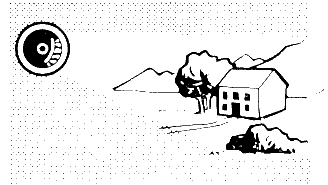 For normal reading point the cell of the exposure meter (usually in the winding knob of the camera) at the subject while observing the latter on the screen. With outdoor scenes point the meter cell slightly downwards to exclude excessively bright sky areas.
For normal reading point the cell of the exposure meter (usually in the winding knob of the camera) at the subject while observing the latter on the screen. With outdoor scenes point the meter cell slightly downwards to exclude excessively bright sky areas.
|
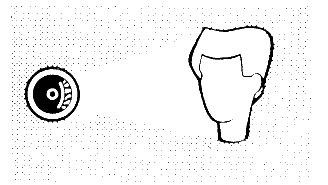 For more accurate readings, especially of figures against a very light or very dark background, go close to the subject so that the meter takes in just the subject itself. For this purpose it is often more convenient to detach the meter from the camera.
For more accurate readings, especially of figures against a very light or very dark background, go close to the subject so that the meter takes in just the subject itself. For this purpose it is often more convenient to detach the meter from the camera.
|
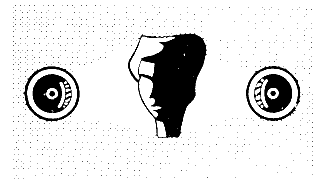 With very contrasty subjects with unpredictable proportions of very bright and very dark areas, take separate close-up readings of the light and dark parts. The correct exposure is then the mean of the two.
With very contrasty subjects with unpredictable proportions of very bright and very dark areas, take separate close-up readings of the light and dark parts. The correct exposure is then the mean of the two.
|
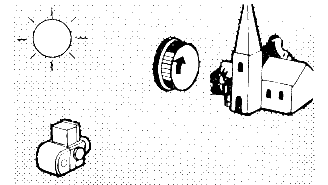 For incident light readings - especially with colour film - move the white plastic blind on the meter knob so that it covers the meter cell. Then point the meter from the subject toward the camera position to be used for the exposure. For this reading it is again often more convenient to remove the exposure meter unit from the camera, rather than carry the latter around for such incident light readings.
For incident light readings - especially with colour film - move the white plastic blind on the meter knob so that it covers the meter cell. Then point the meter from the subject toward the camera position to be used for the exposure. For this reading it is again often more convenient to remove the exposure meter unit from the camera, rather than carry the latter around for such incident light readings.
|
|
Shutter Speed and Movement
The actual shutter speed you need within a series of available aperture-speed combinations is governed by considerations of camera steadiness as well as of subject movement.
An unsteady camera hold results in camera shake, which will lead to inferior definition of the negative. Practical experience goes to show that 1/125 sec. is safe, while you have to hold the camera particularly steady when using 1/60 or 1/30 sec. Where lighting conditions make even longer exposure times essential and there is no subject movement, either support the camera on a tripod, or look round for extra support for your elbows and hands - e.g. a wall, railing, etc.
The shutter speed required to arrest movement depends of course primarily on the speed with which the subject moves. Remember, however, that parts of the subject (e.g. the legs of a runner) may move faster than the subject as a whole; you may sometimes have to compromise and show such parts slightly unsharp. Often that is not a serious fault, as a slight blurring - provided the main part of the subject is sharp - helps to emphasise the impression of movement. Other factors to consider are the distance of the subject - the farther away, the less noticeable the movement blur; the focal length of the lens - a long-focus lens in effect brings the subject nearer; and the direction of the movement. Objects moving across your field of view blur more than if they are approaching or receding.
The most convenient way of allowing for all these factors is with the aid of a simple table (page 69).
Aperture and Depth of Field
When you focus the Hasselblad on a given object, the image of that object will be really sharp on the film. Things nearer or farther away wll be gradually less and less sharp, until they are noticeably blurred. The range of distances over which objects are still acceptably sharp, before you do notice the loss of definition, is known as the depth of field.
You can control the extent of this sharp zone by the lens aperture. As you stop down the lens, the zone of sharpness grows in both directions; as you open up the lens, its depth decreases.
You can obtain the actual zone of sharpness at various apertures and distances from tables, but in practice the most convenient way is to use the depth of field indicator.
0n the lenses for the Hasselblad 500C and Super Wide C this consists of two red pointers above the distance scale of each lens. The pointers are coupled to the aperture setting. They automatically close up at large apertures and move apart at small apertures. One pointer indicates the near, the other the far limit of the depth of field for the distance and aperture the camera has been set to. For example, on the standard lens of the Hasselblad 500C, at 25 ft. and f8, you will find the two pointers opposite 15 and 50 ft., so you have a sharp zone from 15 to 50 ft. At f 16 the distances opposite the pointers may be 12½ ft. and infinite respectively.
Hasselblad 1600F, 1000F and Super Wide have a special scale of aperture numbers marked opposite the distance scale. There are two sets of such numbers from the largest stop (f 2.8) to the smallest (f 22) on each side of the focusing index (the mark that indicates the distance to which you have set the lens).
You will also notice that the depth of field is greater at far distances than at near ones.
Two more points on depth of field.
First, the depth obtained depends also on the focal length of the lens. Short focus lenses yield more depth and tele lenses less depth. That is why the alternative lenses of the Hasselblad have their own depth of field indicator.
Secondly, the sharp zones obtained by the scale or indicator are based on a somewhat arbitrary assumption of how much blurring is acceptable. So depth of field data to, different cameras with the same lens may not always agree, and you are also quite safe in rounding off figures obtained from such data. And if you intend to make really big enlargements from your negatives you can use stricter standards of sharpness by simply stopping down the lens by one stop.
Zone Focusing
With action subjects and similar occasions where you want to shoot quickly, determining sharp zones even with the depth of field indicator wastes too much time. There you need prepared settings covering given near and medium distance ranges that you can easily memorize and set on the camera. Then you only have to worry about keeping the subject within that zone while you shoot.
|
DEPTH OF FIELD
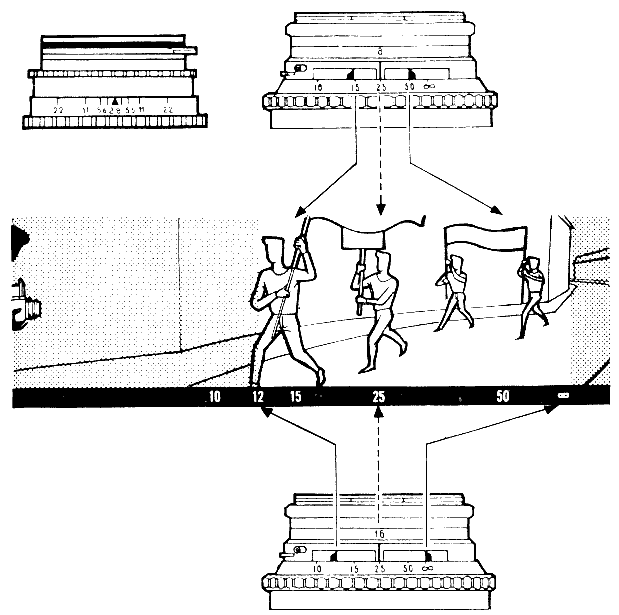
The automatic depth of field indicator fitted to the Hasselblad 500C and Super Wide C consists of two red markers next to the distance scale. These markers indicate the extent of the depth of field available as shown on the distance scale. The field automatically becomes narrower on opening the lens aperture, and gets wider on stopping down. The larger the paerture, therefore, the shallower the zone of sharp focus. Thus with the camera focussed on 25 feet, the depth at f8 will extend from about 15 to 50 ft. (top right); at f16 it will cover a range from 12½ ft. to infinity (bottom). The depth also depends on the actual distance focused (it is less with closer subjects) and on the focal lenght of the lens. Longer focus lenses yield reduced depth of field. Every lens however carries its own depth of field indicator which automatically allows for that.
The Hasselblad 1600F, 1000F, and the original Super Wide have a depth of field scale engraved on the lens mount next to the distance scale. This indicates the depth by means of index lines numbered to correspond to the lens apertures (top left).
|
WORKING IN HOT CLIMATES
High and widely varying temperatures with low humidity, as occur in desert regions and dry seasons, and very high humidity in rainy seasons, call for special precautions to protect the life and continued good performance of the camera. These conditions also cause the growth of moulds on organic matter. Sand, dust and insects may present problems.
The camera should be kept dry and clean. Leather parts should he wax polished, metal parts lightly greased. Never leave the camera unnecessarily exposed to heat. Always keep it in its case, The lens should be covered with a lens cap when not in use; additionally, it should be protected by a colourless filter. Outer lens surfaces have to be kept clean, dirt and grit removed with an air-blower and by tapping. Wipe the lens surface with cotton wool or open mesh fabric (butter muslin), when required.
Store photographic equipment in an airtight metal box or a tin which should be scaled with adhesive (e. g. medical) tape. In a humid atmosphere, add some desiccating agent, e.g. silica gel.
Condensation on the lens may occur when the camera is moved from a cool place into humid heat; this has to be removed before use and the whole camera carefully wiped before re-storing.
Films should not be kept longer than six months in their original air-tight tins (tropical packing) at continual temperatures of 90 degrees F (32 degrees C). At continual 100 degrees F (38 degrees C), the life of most films is limited to a month or two. Keep films for as short as possible a time in the camera.
Films should be processed as soon as possible after exposure - within a week or two, or in very hot, humid climates within a few days. Keep the film in an airtight container with desiccant (to absorb moisture). If possible, keep in a refrigerator, but only if you can dry out the exposed film and the container is sealed.
|
FLASH WITH THE HASSELBLAD
Flash is an efficient light source where no or insufficient daylight is available such as at night, indoors, etc. In the flashlight you carry your own private "sun" with which you can illuminate your subject or scene at any time and place.
THE FLASH BULB is similar to a small electric bulb, However, when current passes through it, it lights up in an intense flash lasting usually about¼0 to 1/60 sec. Each bulb will flash only once and has to be discarded afterwards.
The flash bulb is inserted in a flash gun and the current of the battery fires the bulb, while a reflector fixed behind the bulb makes sure that all the light is directed towards the subject. Most flash guns incorporate a capacitor unit which increases the reliability of firing, even when the battery is nearly exhausted. The shutter speed, provided it is slower than 1/30 sec. (1/60 sec. with small bulbs), has no effect on exposure since the flash is shorter than the exposure time.
Most flash bulbs are available with a clear glass bulb (for black-and-white and negative colour film and for type F reversal colour film) or with a blue-tinted bulb (for daylight type reversal colour films). The blue bulbs can also be used for fill-in lighting by daylight with any type of colour film.
ELECTRONIC FLASH UNITS utilize the discharge of a high-tension capacitor through a flash tube. The power is derived from an accumulator or battery (there are also models working from the mains electricity supply). The electronic flash outfit is rather bigger and heavier than the flash bulb outfit, its comparative light output equals a small flash bulb and its initial cost is higher. On the other hand, anything from 10,000 to 25,000 flashes are obtained from one tube. The flash duration is extremely short (1/700 to½000 sec.) and will arrest the fastest movements. The cost of an individual exposure is negligible.
Electronic flash is suitable for black-and-white and negative colour film and also for daylight type, reversal colour films. It can also be used for fill-in lighting by daylight.
The Hasselblad cameras are synchronized for use with flash bulbs and electronic flash. The handling of the camera models using lenses with Compur shutter (500C, Super Wide and Super Wide C) and those with focal plane shutter (1600F, 1000F) is different and therefore described separately.
Flash with Compur Shutter Models
The cable from the Flash gun is plugged into the flash socket on the shutter. On releasing the shutter, the electric firing circuit automatically closes through the flash socket, setting off the flash at this moment.
A synchronizing lever protrudes at the ide of the shutter. This can be set to X or M.
WITH THE SYNCHRONIZING LEVER SET TO X the shutter closes the flash circuit at the moment when the blades are fully open. Therefore, electronic flash is synchronized at any shutter speed to 1/500 sec. This setting may also be used for flash bulbs of a short firing delay (i.e. bulbs which require only 4-6 milliseconds or½50 to 1/160 sec. to reach the peak of their light output) with the shutter set to 1/60 sec. With older bulbs, the fastest usable speed is 1/30 sec.
WITH THE SYNCHRONIZING LEVER SET TO M the shutter closes the flash circuit 16-18 milliseconds before the shutter blades open to allow for the firing delay of most average flash bulbs. This setting is suitable for normal flash bulbs at all speeds up to 1/500 sec. The M-setting will not synchronize electronic flash or short-delay bulbs.
WITH THE SYNCHRONIZING LEVER SET TO V the delayed-action release for self-portraits comes into action. At the same time the shutter works with X-synchonization. This means that you can work with delayed action and X-synchronized flash; delayed action is not possible with M-synchronization.
Flash with Focal Plane Shutter Models
With these models the shutter is synchronized for the different types of flash with the aid of a synchronizing lever above the accessory shoe (*). The latter carries a flash socket, but a special attachment is required to fit into the shoe for taking the flash cable connection. Two types of this connector attachment are available, with standard European 3-mm. co-axial and American two-pin sockets respectively. The connector carries two sockets for flash bulbs and electronic flash respectively.
Exposure Guide Numbers
The most convenient way of working out exposures with flash is by means of a guide number. When you buy flash bulbs You will always find the guide number for any speed of film printed on the packet. With electronic flash, the guide number is given in the instruction book for the flash unit.
To find the correct aperture to use, divide the guide number by the distance between the flash and the subject. For instance, suppose you find that the guide number of the bulb with the film in use, and the shutter speed required is 160. If you then want to take a photograph at a distance of 10 ft. from the subject, divide 160 by 10 = 16. Therefore the correct aperture to use is f 16. Conversely if you want to use a definite aperture, say f 8, then the correct flash distance is given by 160 / 8 = 20. So the flash must be 20 ft. from the subject.
Synchro-Sunlight
For fill-in flash in daylight, use the normal exposure for the sunlit parts plus a flash exposure based on a doubled guide number.
Example:
Exposure meter reading at 1/60 sec. - f 16.
Guide number for the flash at 1/60 sec. - 120.
The guide number doubled is 240.
Divide 240 by 16-15.
That means that the flashgun should be 15 ft. from the subject. It is advisable to use an extension cable between camera and flashgun This enables you to place the flash farther away from or closer to the subject than the camera
|
FLASH EXPOSURES
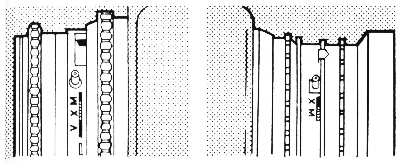
The shutters on the lenses of the model 500C (left) carry a synchronizing lever with three positions: V, X, and M. the V position is the setting for the self-timer, the X and M positions are for different types of flash synchronization (page 54). On the original Super Wide there are only two settings: X and M (right).
|
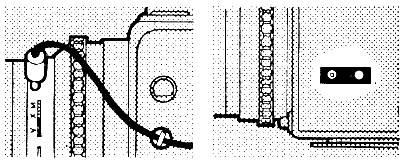
The flash cable plugs into the socket lever (left). A cable bearer fits into one of the two sockets in the left hand side of the camera to prevent accidental pulling out of the cable.
The model 500C also carries a further flash contact in the side of the camera (right) for synchronization of the auxiliary shutter in the camera back (#).
|
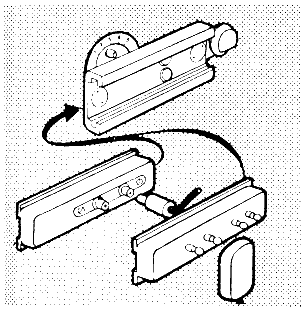
The models 1000F and 1600F have a synchronization contact built into the finder shoe at the side of the camera. The synchronization is here adjustable by moving the small control above the shoe to a series of numbers from 1 to 5. To connect the flash, a flash shoe fits into the finder shoe. The flash shoe carries either two co-axial sockets, or two pairs of two-pin sockets (older version). The outlets in each case are marked "flash" (for flash bulbs) or "strobe" (for electronic flash).
|
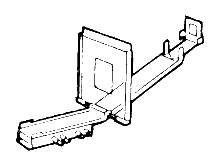
For these models a special frame finder used to be available carrying similar flash outlets in the finder foot, to permit connection of flash units when working with the frame finder.
|
|
THE INTERCHANGEABLE LENSES
The Hasselblad cameras, except the Super Wide models, have an interchangeable lens and a range of alternative focal lengths is available. The field of view covered by the standard 80-mm. lens is most suitable for the majority of subjects. For specialized purposes a greater or reduced field of view has distinct advantages.
Wide-angle Lens
A wide-angle lens is a lens of shorter focal length, it sees and reproduces more of the subject in front of the camera than does the standard lens.
Such a wide-angle lens has definite advantages in cases where the practicable distance between camera and subject is limited and insufficient for the standard lens to record the subject in is entirety. The wide-angle lens is, therefore, primarily used for architectural photography and interiors.
In view of the short focal length, the depth of field covers a particularly wide zone even at full aperture. It can, therefore, be employed with advantage as a quick-shooting lens for general purposes where accurate focusing or distance-setting would be inconvenient (e.g. insufficient time).
To get a large image, even of a near object, you have to go really close to it. Near objects then tend to dwarf more distant ones, and the resulting picture shows pronounced perspective effects. In this way. the wide-angle lens can be used to emphasize perspective.
Telephotography
A tele lens on the other hand has a smaller angle of view than the standard lens. It is of longer focal length, and reproduces less of the subject in front of the camera than the standard lens does, but on a larger scale.
Such a lens is particularly suitable for subjects that are difficult to approach closely, such as animals, children, architectural detail, sports events, etc. In photographing distant views without near foreground, it brings the subject nearer. It also permits a greater camera-to-subject distance in portraiture, producing a more pleasing and subdued perspective. At the same time, its lesser depth of field concentrates definition on the portrait, avoiding a sharp background which would detract from the main object.
Focusing and Viewing
Focusing with the wide-angle or telephoto is much the same as with the standard lens. The Hasselblad reflex screen enables the image to be focused accurately; at the same time the screen shows the exact field of view of the particular lens used. There is no parallax error.
|
THE HASSELBLAD LENSES
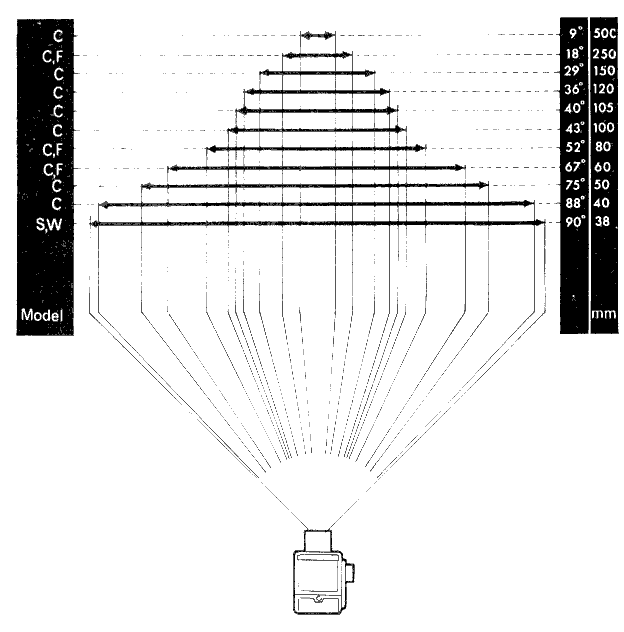
The shorter the focal length of the lens, the greater the angle of view taken in. With the interchangable lenses the Hasselblad can thus control the angle of view - and also the scale of the image recorded.
This diagram indicates the main lenses available for the Hasselblad camera, with their focal lenghts and angles of view. The letters show the models for which the focal length are available. C stands for the Hassselblad 500C, F for the models 1000F and 1600F, and SW for the Super wide and Super Wide C (the lens for this camera is not interchangable).
|
THE HASSELBLAD : MODEL BY MODEL
This section deals with the individual Hasselblad cameras in detail.
|
THE HASSELBLAD 500C
The Hasselblad 500C is the standard camera of this series, with interchangeable lenses, and finder systems, interchangeable winding knob and interchangeable roll film magazine backs.
Each lens comes in its own Synchro-Compur shutter giving automatic speeds of 1,½,¼, 1/8, 1/15, 1/30, 1/60, 1/125,½50, 1/500 sec., and B for time exposures. The shutter is synchronized for flash bulbs and electronic flash at all speeds, and incorporates a delayed-action release and an exposure value scale. The lenses have automatic and manual pre-selector iris control and automatic depth of field indicators.
In addition an auxiliary shutter is built into the back of the camera body. It consists of two movable blades, which remain closed as long as the mirror is in the lower position and the reflex ground glass screen image is visible. It prevents the light from falling on the film when focusing or changing lenses, since this can only be done when the mirror is lowered and the shutter open.
This shutter can also be used as an auxiliary shutter with exposures of½5 sec. or longer, when the camera is used with the extension bellows for macro-photography or photomicrography, or with special lenses without their own shutters. This shutter has its own flash contact (see page 54).
The standard lens of this model is the 80-mm. Zeiss Planar f 2.8. Alternative lenses cover focal lengths from 60 to 500 mm. (*).
FOR CLOSE-UP WORK Proxar lenses, extension tubes, extension bellows and a transparency copy holder are available.
OTHER ACCESSORIES INCLUDE: magazines, the sheet film adapter, the magnifying hood, eye-level pentaprism, sports finders, rapid winding crank, winding knob with exposure meter, quick tripod coupling, lens mount adapter, microscope adapter, microscope shutter, filters, lens hood, diffusion discs, quick focusing handles, camera grip, spirit level, flash bracket, squared screen, and ever-ready and outfit cases.
Shooting
1. Wind the film transport by turning the transport knob one turn to a full stop. This advances the film to the next frame, lowers the mirror, and tensions the shutter. It further sets the signal on the camera indicating that the shutter is tensioned (white), sets the signal on the attached magazine to show that the film is advanced (white), and opens the shutter and iris diaphragm,
If you cannot turn the film transport knob, this may be due to:
(a) the last film frame being exposed, leaving no number in the film window;
(b) using the shutter at the B setting and not resetting the time catch to its original position (see below: Time exposure); or
(c) pressing the quick release button without actually taking the exposure (see below: Quick release); or
(d) trying to wind on before the shutter, particularly when set to a slow exposure, e.g. 1 sec., has fully run down.
2. Open the reflex hood for a preview of the picture you intend to take.
3. Set the exposure value. The shutter rim carries a range of numbers engraved in red from 2 to 18. These are exposure values for correct exposure. Each exposure value represents a range of shutter-speed aperture combinations of equivalent exposure. To set the exposure value, slightly push back the wormed lever on the rim behind the exposure values and move the triangular mark beside the lever to the appropriate exposure value (obtained from exposure table or a meter) on the scale. Intermediate exposure values, e.g, 10½, 11½, etc., can also be set.
4. Select the aperture-speed combination by turning the milled shutter ring. Aperture and speed scales here move together. The figures opposite each other represent alternative combinations corresponding to the exposure value set. Again only the aperture and speed actually opposite the black central index line on top of the shutter are the ones to use. To set apertures and speeds separately (e.g, for flash shots) adjust first the shutter speed and then the aperture on the exposure value setting ring.
5. Frame the image on the reflex screen and determine the exact field to be photographed.
6. Release the shutter gently. Keep the release button depressed for the duration of the exposure. This is of some importance when using slow speeds; if you let the release button go earlier, the auxiliary shutter stops the exposure.
|
THE HASSELBLAD 500C
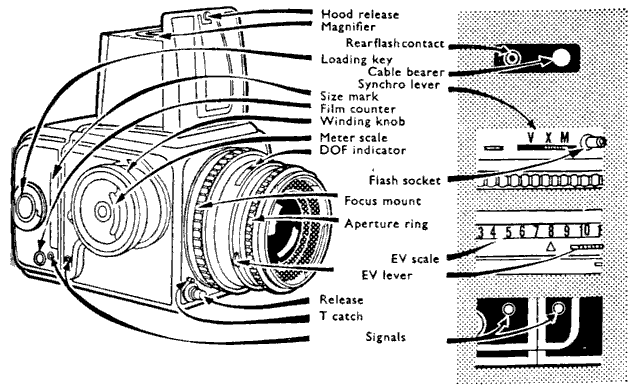
The hood release opens the focusing hood and the magnifier. The rear flash contact serves for synchronizing the auxiliary focal plane shutter in the back of the camera. The loading key advances the film for the first exposure. The synchronizing lever sets the synchronization and the self-timer. The size mark indicates the type of magazine in use. The film counter shows a number of exposures taken. The winding knob advances the film and tensions the shutter, it also incorporates the exposure meter. The depth of field indicator is coupled with the aperture ring of the lens. The focusing mount sets the lens to the correct distance. The exposure value scale and exposure value lever select the exposure value. The aperture ring also sets aperture-speed combinations. The release incorporates a catch to hold it down for time exposures. The signal in the side of the camera magazine indicates whether the frame has been exposed or the film advanced.

Shooting with the 500C. From left to right: Wind the film transport; view and focus the image on the screen; set the exposure value; select a suitable aperture-speed combination; press the release to expose.
|
Special Controls
FOR TIME EXPOSURES set the index of shutter speed ring to B (= brief time).
The green figures represent full seconds corresponding to the aperture value opposite them at a given exposure value. If you want to use one of these apertures, note the time opposite it. Set the aperture separately by depressing the exposure value lever and turning the aperture ring. (Leave the shutter speed ring at B.) Then expose for the time which was previously opposite that aperture value.
For time exposures always use the cable release. This screws into the centre of the body release on the camera body. For long time exposures, where it is inconvenient to keep the release depressed, a time catch can be brought into action. The time catch is the small lever with red spot in its top. Push this lever to the T position; the shutter will, on releasing, remain open until this catch is pushed back to the O position.
THE AUXILIARY SHUTTER. The main function of this is to protect the film from light when focusing, changing lenses, etc. It can also be used as a shutter at½5 sec. when working with special lenses lacking a shutter, in macrophotography and photomicrography. It has its own flash contact in the side wall of the camera body. The flash cable is connected to this contact. The shutter is X-synchronized and can therefore be used with electronic flash and normal "M"-type flash bulbs.
THE DELAYED-ACTION RELEASE built into the Synchro Compur releases any speed set from 1 sec. to 1/500 sec. with 8½ sec. delay. It is brought into action by moving the green level on the left of the shutter to V while pressing the small protruding lock at the left at the same time. Set the time catch on the camera release to T. After the self-timer exposure, reset the time catch to O, otherwise you cannot transport the film.
FLASH SETTINGS. For X- or M-synchronization, set the green lever on the left part of the shutter to X or M, while depressing the small protruding lock at the left. The cable bearer can be connected to the body of the camera. This is a hook with a ball at its end. The ball is pushed into the recess beside the auxiliary shutter flash contact of the camera body. The protruding hook holds the flash cable to secure it to the flash plug.
CHANGING THE WINDING KNOB. The film transport and shutter tensioning knob of the Hasselblad 500C is interchangeable and can be replaced by a knob with exposure meter, or crank, etc.
Removing the knob is best done after winding it ready for an exposure. Push the catch on the rim of the knob away from the camera body with the thumb of your right hand, while turning the knob anticlockwise. This action releases it from its bayonet base.
To attach the knob, position the circular red mark on its rim opposite the red triangular mark on the camera body. Then turn the knob clockwise. When the triangular mark points to the solid red mark on the knob, the latter is secure.
RAPID EXPOSURE. To reduce the time between releasing and the instant of exposure - normally 1/10 sec. - to the absolute minimum, press the quick release button which is situated just below and to the left of the film transport knob. (It does not need to be held down.) This closes the camera shutter, opens the auxiliary shutter, lifts the mirror and sets the aperture to the pre-selected value. The picture on the ground glass is no longer visible. On pressing the normal release button to take the picture, only the between-lens shutter operates, cutting down the interval from releasing to the instant of exposure to 1/60 sec.
Once you have operated the quick release button, you must still release the shutter before you can turn the winding knob.
The quick release button is therefore useful for sports and action shots. The subject must of course be observed through a sports or frame finder.
|
SPECIAL HASSELBLAD 500C CONTROLS
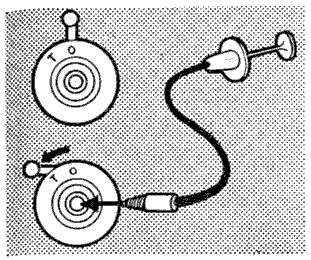
For time exposures (with the shutter set to B) the time catch on the release keeps the shutter open after pressing the release. For this purpose move the catch to the position T before releasing. Preferably make time exposures with a cable release; this screws into the release button. The shutter closes again on moving the time catch to the position O.
|
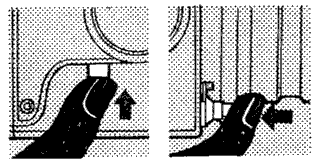
The quick-release button below the winding knob (left) reduces the time delay in shooting. Pressing the button closes the camera shutter, opens the auxiliary shutter, lifts the mirror and presets the aperture. Pressing the normal release button (right) then only releases the he shutter - and does so at once. When using the quick-release button, the image is not however visible on the focusing screen, and a separate sports finder must be used.
|
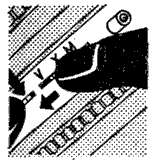
Left: To use the self-timer set the synchronizing lever to the position V, while pressing the locking catch next to it. This must be done after tensioning the shutter. The time catch must also be set to T. On pressing the release the shutter opens after a delay of about 8 seconds.
Below: To change the winding knob (for example to fit the plain winding knob instead of the exposure meter knob or vice-versa) press the catch on the rim and turn the knob anti-clockwise (left), then lift off. To attach the knob, place it in position with its red circle opposite the red triangular mark on the body (centre), then turn clockwise to engage the bayonet lock (right). The solid red mark must now be opposite the red triangle.
|
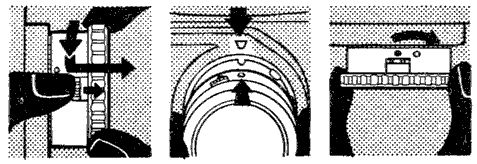
|
|
THE HASSELBLAD 500EL
The Hasselblad 500EL is basically a Hasselblad 500C, but it has an electric motor drive built into its base. This motor undertakes the mechanical tasks of advancing the film and cocking the shutter, giving the photographer greater freedom to concentrate on the actual photo graphic work, focusing and exposing. The motor is powered by one or two rechargeable batteries, each giving 1,000 exposures per charge.
The camera uses the same lenses and shutter, finder and magazine unit as the Model 500C. As it is best used with the magazine giving 70 pictures, it is usually supplied as the 500EL/70.
Shutter Release Methods
The shutter release of the Hasselblad 500EL can be operated in the following ways:
1. By release knob on the camera in the conventional way.
2. With the remote control cable at varying distances from the camera of up to 100 ft. or, with an amplifier, up to 200 yards.
3. By remote control radio signal without cable connection.
4. Automatically with an electric timer for programmed exposure at fixed intervals.
5. Automatically to take a series of rapid sequence shots.
Additionally, there are five different ways of making exposures.
The chosen method is set on the selector scale on the side wall of the camera. The effect of these settings is:
1. With the indicator set to "O" (- normal setting), the film is advanced after exposure, the shutter is cocked and the mirror returns to the focusing position.
2. With the indicator set to "S" (- speed setting), the reaction time between release and exposure is reduced to a minimum because with this setting, the mirror is lifted, the auxiliary shutter is opened and the diaphragm is slipped down to the pre-set value beforehand.
3. With the indicator set to "SW' (- speed repeat setting), the result is the same as With the "S" setting above, but the camera remains at this setting after exposure.
4. With the indicator set to "A" (- automatic setting), the camera continues to make exposures as an exposure signal is given and the magazine exposure counter shows that it contains unexposed film. The exposure signal can be given, for example, by a release cord. The time between each exposure is approximately 1 sec. The exposure values from 1 - 1/15th sec. should be avoided but if they have to be used, it is important that the release button remains depressed until the between-lens shutter completes the exposure. Otherwise the auxiliary shutter will close and interrupt the exposure.
5. With the indicator set to "AS" (=automatic speed setting), the result is the same as at the automatic setting above, except that the camera remains at the "S" setting after the exposure signal.
B and T Exposures
Exposure times between 1 sec. and 1 minute, which are to be released by means of the release button or remotely by radio or cord, should have the shutter set to "B". For time exposures in excess of 1 minute, the shutter should be opened by moving the lever to "T" (with the shutter set to "B"). To close the shutter, set the time lever back to the "O" setting. This advances the film and cocks the shutter. To save the batteries use the time lever for exposures in excess of 1 minute and also when making exposures with the self-timer.
Alternative Release Methods
There are two releases on the camera front and one on the side. Normal exposures are made with a release button, which can be attached to either of the two front sockets.
To work away from the camera, release cords measuring 1 ft., 10 ft. or 20 ft. can be connected to either of the two front sockets. When using these cords, the release button need not be removed and can be used as an alternative release.
The side socket is used to recharge batteries in the camera with the recharge unit and also in conjunction with the release cord SK150 when making exposures at greater distances from the camera, e.g. with the 100 ft. connecting lead.
Programmed exposure with fixed intervals from one frame every 2 seconds to one frame every 60 hours can be obtained with the timer. This is connected to the side socket of the camera. The timer is electric and runs off a mains supply.
Remote-control Release by Radio
A receiver is mounted to the camera accessory shoe and takes power from the camera batteries. A tone transmitter operating on a 27 mc/s radio control band is employed to send a release signal to the camera. (In Britain, Post Office authority is required to operate this equipment).
The Hasselblad 500EL Batteries
The electric motor is powered by one or two rechargeable nickel cadmium batteries. With one battery, 1,000 exposures can be made on each charge. With two batteries, 2,000 exposures are possible before recharging.
The recharging unit Model I is supplied with the camera and is designed to recharge one or two batteries in the camera. The recharging time for each battery is 14 hours. A recharging unit Model II is available, intended for charging batteries in the camera or in the Hasselblad battery box. It is equipped with adjustable timer which automatically stops the charging after the pre-set time has elapsed.
|
THE HASSELBLAD 500 EL
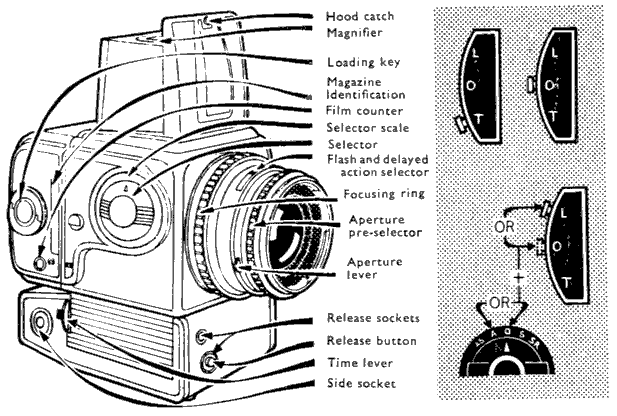
The 500EL is basically a 500C, but it has additional controls. The time fever, shown at right above, is used for exposures from 1 second to 1 minute and when making exposures with the self-timer. Moving the lever to T (with the shutter set to B) opens the shutter. Moving the lever to O closes the shutter, advances the film and re-cocks the shutter. When changing lenses, the time lever must he set to L or O and the selector scale (see below) set to A or O.

The selector scale on the 500EL The figures used here correspond to those on page 7 of this section: 1. Normal setting. 2. Speed setting. 3. Speed repeat setting. 4. Automatic setting. 5. Automatic Speed setting.
|
THE HASSELBLAD 1600F AND 1000F
These models use interchangeable lenses and finder systems, and interchangeable roll film backs. They are fitted with a stainless steel focal plane shutter. The lenses therefore do not have their own shutter. The shutter is synchronized for flash bulbs and electronic flash.
All the interchangeable lenses, except 250 mm., are fitted with a manual pre-selector iris and all have a depth of field indicator. The standard lens is the 80-mm. Ektar f 2.8; the later models of the 1000F are fitted with the 80-mm. Zeiss Tessar f 2.8. Alternative lenses cover focal lengths from 135 to 250 mm.
THE MODEL 1600F has shutter speeds from 1 sec. to 1/1600 sec. and B.
THE MODEL 1000F has shutter speeds from 1 sec. to 1/1000 sec. and B.
FOR CLOSE-UP WORK extension tubes, extension bellows and transparency copy holder are available.
OTHER ACCESSORIES INCLUDE: Magazines, the sheet film adapter, the magnifying hood, eye-level pentaprism, sports finders, quick tripod coupling, filters, lens hood, flash gun bracket, squared screen and ever-ready and outfit cases.
Shooting
- Wind the film transport by turning the transport knob one turn to a full stop. This advances the film to the next frame, lowers the mirror, and tensions the shutter. It further sets the signal on the camera indicating that the shutter is tensioned (white), and sets the signal on the attached magazine to show that the film is advanced (white).
If you cannot turn the film transport knob, this may be due to the last film frame being exposed, leaving no number in the film window. This occurs with magazines above Serial No. 20,000.
- Open the reflex hood for a preview of the picture you intend to take.
- Set the shutter speed. Pull out the film transport knob and turn it clockwise (on 1600F you can turn either way) to bring the required speed (engraved on the knob) opposite the red triangular mark on the camera body. Then let knob spring back. This can be done after operating the transport knob.
- Set the aperture. Slide the trigger handle protruding near the front of the lens to the left and turn the aperture setting ring to the aperture you want to use.
- Focus by turning the front serrated lens ring while observing the screen, and determine the exact field to be photographed.
- Stop down and release. As soon as you are ready to take the picture slide the trigger on the lens mount to the right as far as it will go. The lens is now stopped down to the aperture you had preselected (see above, No. 4). The red rectangle on the aperture ring will then point to the red dot on the aperture scale. Now release the shutter gently by pressing the button.
Special Controls
FOR TIME EXPOSURES set the shutter speed indicator to B (= brief time). On releasing, the shutter will remain open as long as the release button is pressed down and closes as soon as the pressure on the release is removed.
For time exposures always use a cable release. This screws into the release socket on the bottom front corner of the winder side of the camera body. Unscrew the dust cover with the tip of the index finger. For long time exposures, where it is inconvenient to keep the release depressed, a cable release with time lock is useful. After depressing the plunger, engage the catch or tighten the locking screw to keep the shutter open. Disengage the time catch to close the shutter.
FLASH SETTINGS. For flash the special flash connection or the frame finder with flash connection is required. This goes into the accessory shoe on the side of the camera body, and carries two flash sockets. Push in the attachment as far as it will go; it must click into position to establish the correct flash contact.
There are two models of this socket connection. One carries the now discontinued U.S.-type twin pins. The other has 3-mm. co-axial flash socket. Either type of socket has two outlets marked flash and strobe respectively. When using the U.S.-type twin-pin socket, the flash gun has to be insulated from the camera, to avoid short-circuits.
Above the accessory shoe fitting on the camera there is a pointer and a semi-circular plate engraved with numbers from 1 to 5. The pointer adjusts the flash synchronization for different types of flash bulbs.
The Hasselblad with focal plane shutter should only be used with focal plane flash bulbs which have a long flash duration. These are generally marked F.P. When working with flash bulbs, connect the flash cable to the outlet socket marked Flash. Then set the synchronization according to the table on page 59. If your first tests show that the negative is not evenly exposed, the synchronization can be adjusted. If the negative is thinner on the side with the two notches, move the pointer to the next higher figure; if it is thinner on the opposite side, set the pointer to the next lower figure.
When working with electronic flash, connect the flash cable to the socket marked Strobe. This bypasses the synchronization adjustment and its position is irrelevant. The shutter speed with electronic flash must be set to½5 sec. or slower.
Class M flash bulbs (non-focal plane types) can also be synchronized at½5 sec. by using the electronic flash socket.
The sports frame finder made for the F models occupies the accessory shoe space required by the flash socket. This finder, except its earliest version, is therefore so constructed that it contains in its base the flash sockets. Finders with U.S. or 3-mm. co-axial fittings are available.
|
THE HASSELBLAD 1000F AND 1600F
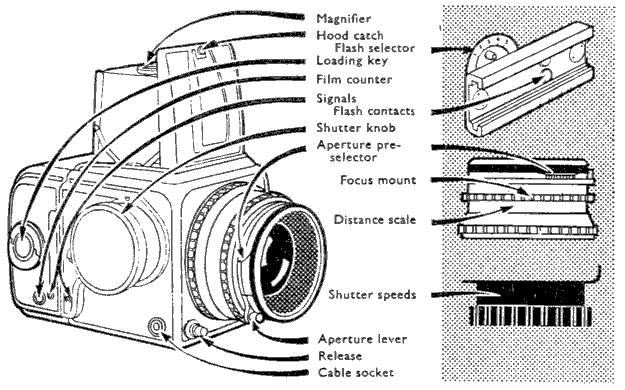
The hood catch opens both the hood and the magnifier. The flash selector sets the appropriate synchronization for different types of flash. The loading key advances the film to the first exposure. The film counter indicates the number of frames exposed. The signals on the camera and magazine show the state of operation of both. The flash contacts in the finder shoe connect to outlets on the slide in adaptors. The shutter knob advances the film and tensions the shutter, as well as setting the shutter speed. The aperture preselector presets the required lens opening. The focusing mount, next to the distance scale sets the lens to the appropriate distance. The shutter speeds are marked on the barrel of the shutter knob. The aperture lever or trigger stops down the lens immediately before the exposure to the preselected value.

Shooting with the F models. From left to right: Wind the film and tension the shutter; view the subject on the screen and focus the lens; set the shutter speed; preselect the lens aperture; close down the lens to the preselected value and press the release.
|
THE HASSELBLAD SUPER WIDE C AND SUPER WIDE
These Hasselblad models are part of the Hasselblad system. While they are specialized cameras in their own right, they can also be considered as front attachments to the Hasselblad 500C, 1600F or 1000F.
The Super Wide is an extreme wide-angle camera. With an angle of view of 90 degrees, it offers a subject field four times larger than the standard 80-mm.. lens with its angle of view of 52 degrees. This feature is of greatest value when taking photographs in limited space indoors, and for architectural and industrial photography.
The lens is the 38-mm. Zeiss Biogon f 4.5. It is an 8-element construction, focusing from 12 in. to infinity. The image is free from vignetting even at full aperture and the lens is fully corrected for distortion and colour rendering. It accepts Hasselblad type 63 (Series VIII) filters which are retained by a filter ring on the lens front
The body is very shallow, as this camera has no reflex focusing system. Nor is that needed, as the extreme short focal length of the lens provides a very large depth of field. A spirit level is let into the camera top.
The Super Wide models use the interchangeable film back for standard Hasselblad roll film magazines and sheet film holder. The back also accepts the ground glass adapter and magnifying hood.
The top of the camera carries a removable optical direct vision viewfinder with prism to observe the spirit level.
The shutter is synchronized for flash bulbs and electronic flash and has a delayed-action release.
THE SUPER WIDE C has a Synchro-Compur shutter with speeds of 1,½,¼ 1/8, 1/15, 1/30, 1/60, 1/125,½50, 1/500 sec. and B. The shutter is automatically tensioned on advancing the film by the film winding crank. It carries an exposure value scale and automatic depth of field indicators. The base has fitting for instant tripod attachment. The release button is in the top of the camera body.
THE SUPER WIDE has a Compur shutter with speeds of 1,½, 1/5, 1/10,½5, 1/50, 1/100,½50, 1/500 sec. and B. The shutter has to be tensioned independently. A knob is fitted for film transport and a depth of field scale is opposite the distance scale. The release button is on the base of the camera front plate.
ACCESSORIES include the Super Wide viewfinder, flash gun bracket, magnifying hood, ground glass adapter, magazines, sheet film adapter, quick tripod coupling, filters, and cases.
Shooting
1. Wind the film transport one turn to a full stop.
2a. Set the exposure value on the Super Wide C. The shutter rim carries a range of numbers engraved from 3 to 18. These are exposure values for correct exposure. Each exposure value represents a range of shutter speed-aperture combinations of equivalent effective exposure. To set the exposure value, slightly push back the serrated lever on the rim behind the exposure values and move the triangular mark beside the lever to the appropriate exposure value (obtained from exposure tables or a meter) on the scale. Intermediate exposure values, e.g. 10½, 11½, etc., can also be set.
2b. Set the exposure time and tension the shutter on the Super Wide. Turn the ring behind the front lens mount until its index points to the shutter speed required. The engraved numbers 1, 2, 5, 10, 25, 50, 100, 250, 500, indicate fractions of a second and stand, therefore, for½, 1/5, 1/10,½5 sec., etc. Then push up the shutter tensioning lever, which is situated between the aperture scale and the flash socket.
3a. Select the aperture-speed combination of the Super Wide C by turning the milled shutter ring. Aperture and speed scales here move together. The figures opposite each other represent alternative combinations corresponding to the exposure value set. Again only the aperture and speed actually opposite the black central index line on top of the shutter are the ones in use. To set apertures and speeds separately (e.g. for flash shots), adjust first the shutter speed and then the aperture on the exposure value setting ring.
3b. Set the Aperture on the Super Wide by moving the lever behind the aperture scale until its index points to the aperture selected.
4. Set the distance. Focus by turning the large milled ring on the rear of the lens mount to bring the required distance figure opposite the index.
5. View the subject through the finder. Watch the spirit level through the prism. Perfect alignment is essential to avoid distorted vertical and horizontal lines.
6. Release the shutter gently.
Special Controls
FOR TIME EXPOSURES set the index of the shutter speed ring to B (= brief time).
On the Synchro-Compur shutter of the Super Wide C the green figures represent full seconds corresponding to the aperture value opposite them at a given exposure value. If you want to use one of these apertures, note the time opposite it. Set the aperture separately by depressing the exposure value lever and turning the aperture ring. (Leave the shutter speed ring at B.) Then expose for the time which was previously opposite that aperture value.
For time exposures use a cable release to avoid camera shake. On the Super Wide C this screws into the centre of the body release. For long time exposures, where it is convenient to keep the release depressed, a time catch can be brought into action. The time catch is the small lever with red spot in its top. Push this lever to the T position; the shutter will, on releasing, remain open until this catch is pushed back to the O position.
On the Super Wide the cable screws into the cable release socket beside the release button. When not in use, the cable socket is covered by a dust-excluding screw which has to be removed to insert the cable release. As well as a standard cable release, a time lock cable can be employed which has a locking device on the base of the plunger. For long time exposures a cable release with time lock is useful.
THE DELAYED-ACTION RELEASE built into the shutter releases at any speed set from 1 sec. to 1/500 sec. with 8½ sec. delay. It is brought into action on the Super Wide C by moving the green lever on the left part of the shutter to V while pressing the small protruding lock on the left at the same time. On the Super Wide model first tension the shutter, and then press the milled knob to the left of the tensioning lever forward and tension again as far as it will go.
FLASH SETTINGS. For X- or M-synchronization, set the lever to the left of the shutter to X or M.
On the Super Wide C depress also the small lock protruding on the left of the shutter. This model is supplied with a cable bearer. This is a hook with a ball at its end. The ball is pushed into the hollow on the side wall of the body-above the name plate. The protruding hook will hold the flash cable to secure it to the flash plug.
|
THE HASSELBLAD SUPER WIDE C
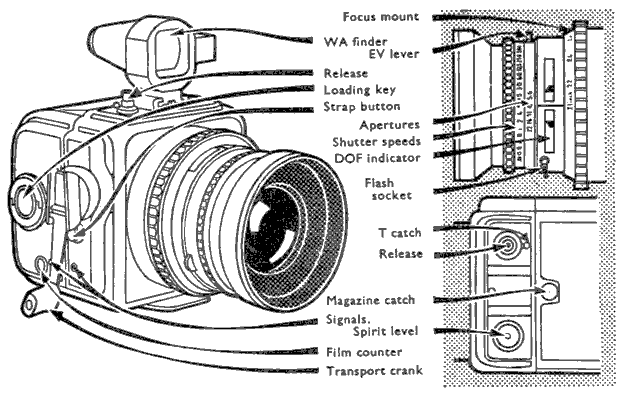
The focusing mount is the rearmost ring on the lens and carries the distance scale. The wide-angle finder in distance scale. The wide-angle finder incorporates a prism for viewing the spirit level during shooting. The exposure value lever sets the exposure value; the shutter speed ring is then used to selectr suitable aperture-speed combinations. The release incorporates a catch for time exposures. The loading key on the magazine advances the film for the first exposure. The strap button takes the carrying strap. The depth of field indicator is coupled with the lens aperture setting. The signals on the camera magazine indicate the state of readiness (after exposure or after film transport). The film counter shows the number of exposures taken. The transport crank advances the film and at the same time tensions the shutter.

Shooting with the Super Wide C. From left to right: Wind the film transport; set the exposure value; select an appropriate aperture-speed combination focus the lens (by estimating the distances); view the subject through the wide-angle finder and press the release.
|
THE ORIGINAL SUPER WIDE
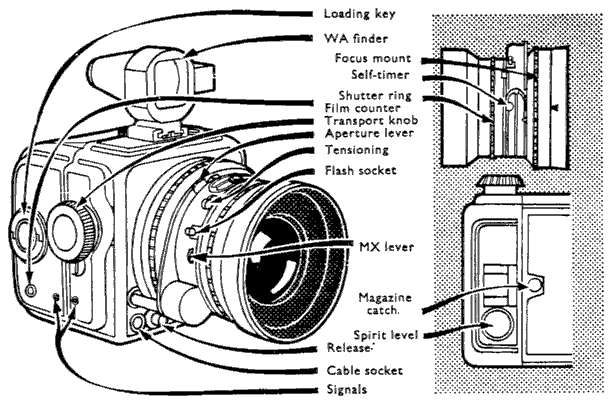
The loading key advances the film to the first exposure, after which the film counter in the side of the magazine indicates the number of exposures made. The wide angle finder incorporates a prism to show the spirit level. The self-timer on the shutter permits delayed releasing. The shutter speed ring acts the shutter speeds, and the aperture lever the apertures; these two are not interconnected. The transport knob advances the film, but the shutter must be tensioned separately with the tensioning lever. The Posh socket takes standard co-axial plugs; the MX lever selects the type of synchronization. A cable release socket is mounted next to the release button. The signals on the camera and magazine indicate whether the picture has been exposed or the film needs advancing.

Shooting with the Super Wide. From left to right: Wind the film transport knob; set the aperture and shutter speed separately; tension the shutter; set the lens to the appropriate subject distance; view the subject through the finder and release the shutter.
|
HASSELBLAD LENSES AND FINDERS
Lenses for the Hasselblad 500C
Every interchangeable lens for the Hasselblad 500C camera has its own built-in Synchro-Compur shutter, automatic and manual aperture adjustment, automatic depth of field indicators, exposure value scales and delayed action.
The iris diaphragm on the latest versions of the Hasselblad 500C lenses has a special release lever to stop down the lens to its preselected aperture during viewing. This lever is on the shutter rim on the winding knob side of the camera when the lens is mounted on the Hasselblad, and protrudes between the words "Synchro" and "Compur" engraved on the shutter. Pressing the lever down closes the aperture; this provides a preview of the depth of field of the screen image. The latter is of course then correspondingly dimmer.
The iris then remains closed down to that value until you press the shutter release and tension the shutter again with the winding knob. If you want to open up the lens to full aperture again before shooting, set the aperture selector ring to the maximum aperture, and then to the required smaller aperture again. The iris now once more remains fully open until you release the shutter (or press the preview lever).
The series of lenses consists of:
THE 40-mm. ZEISS DISTAGON is an extra wide-angle lens with an angle of view of 88 degrees consisting of ten elements, has a focusing range from 20 in. to infinity and apertures from f 4 to f 32. The lens accepts Hasselblad filters series 104.
THE 50-mm. ZEISS DISTAGON f 4 is a wide-angle lens with an angle of view of 75 degrees (as compared with 52 degrees of the standard lens). It consists of seven elements, has a focusing range from 20 in. to infinity and apertures f 4 to f 22. The lens accepts series 63 filters. This lens has replaced the 60-mm. lens.
THE 60-mm. ZEISS DISTAGON f 4 (up to 1961 it was supplied with aperture f 5.6) is a wide-angle lens. The angle of view of this lens is 67 degrees. It consists of seven elements, has focusing range of 21 in. to infinity and apertures from f 4 (or f 5.6) to f 22 The lens accepts Hasselblad filters series 63.
THE 80-mm. ZEISS PLANAR f 2.8 is the standard lens of the Hasselblad 500C camera. It is a seven-element construction (originally six-element) with an angle of view of 52 degrees, a focusing range from 3 ft. to infinity, and apertures from f 2.8 to f 22. The near focusing limit can be extended by Proxar lenses, extension tubes, and the extension bellows ( ** ). This lens accepts Hasselblad filters, series 50 with bayonet mount, and a series 80 bayonet lens hood. For infra-red film use a position 9.5 mm. to the right of the central distance indication line as the focusing index.
THE 100 mm. f 3.5 ZEISS PLANAR has a particularly flat field (for photogrammetric use), is a slightly longer than normal length lens of seven-element construction, with an angle of view of 43 degrees and a focusing range from 3 ft. to infinity and apertures from f 3.5 to f 22. Intended for use specially calibrated together with camera body and magazine 70.
THE 105 mm. f 4.3 ZEISS UV SONNAR. This is a seven-element construction with an angle of view of 40 degrees and a focusing range from 6 ft. to infinity. Apertures from f 4.3 to f 32. Available to special order only with enhanced UV transmission for use with UV materials by scientists and technologists, especially when examining old or altered documents, etchings, tapestries, paintings, finger prints on various surfaces, etc.
THE 120-mm. ZEISS S-PLANAR f 5.6 is a long focus lens giving 1.5 x magnification as compared with the standard lens. It is a six element construction and has an angle of view of 36 degrees. The focusing range extends from 3 ft. to infinity and apertures are f 5.6 to f 32. The lens accepts series 50 filters with bayonet mount. For near focusing distances extension tubes ( ** ) and extension bellows are available.
THE 150-mm. ZEISS SONNAR f 4 is the most universal long-focus lens, giving almost 2x magnification as compared with the standard lens. It is a five-element construction, and has an angle of view of 29 degrees The focusing range extends from 5 ft. to infinity, and apertures from f4 to f32. For near focusing distances extension tubes ( ** ) and extension bellows are available. This lens accepts Hasselblad filters series 50 with bayonet mount and a 150/250 bayonet lens hood. For infra-red film use a position 4.2 min. to the right from the central distance indication line as the focusing index.
THE 250-mm. ZEISS SONNAR f 5.6 is a tele lens for close-ups of distant subjects. It yields more than 3 times magnification as compared with the standard lens. It is a four-element construction, with an angle of view of 18 degrees, and has a focusing range from 8 ft. to infinity. For nearer shots, extension tubes and the extension bellows can be used ( ** ). Apertures are adjustable from f 5.6 to f 45. This lens accepts Hasselblad filters series 50 with bayonet mount and the 150/250 bayonet lens hood. For infra-red film use a position 5.1 mm. to the right from the central distance indication line as the focusing index.
THE 500-mm. ZEISS TELE TESSAR f8 is a tele lens tor extreme magnification. Its main applications include special jobs in press, expedition and wild animal photography. It is the first extreme tele lens with Compur shutter and automatic aperture setting. It is a five-element tele construction; the distance from the front lens element to the film plane is only 380 mm. It yields a linear magnification of 6¼ times as compared with the standard tens, with an angle of view of 9 degrees. The focusing range is from 28 ft. to infinity; the apertures are adjustable from f 8 to f 64. The lens accepts Hasselblad series 86 filters with threaded fitting and threaded lens hood. The latter is supplied with the lens.
Changing the Lenses of the 500C
The lenses have a bayonet mount with four retaining lugs, and one starting point only.
REMOVING THE LENS. The shutter has to be tensioned before the lens can be removed. Depress the lens catch in the right bottom corner of the front of the camera body, hold the entire lens mount with your right hand and turn it anti-clockwise by a one-fifth turn. Then lift off the camera body.
FITTING THE LENS. A lens can only be attached to the camera when its shutter is tensioned. Normally, winding the film transport knob tensions the shutter. With the lens removed from the camera, the groove on the tensioning shaft in the rear of the lens should then point to the red mark beside it. If the shutter was released while the lens was removed from the camera it must be re-tensioned before the lens can be inserted. The simplest way of tensioning the shutter is to place the edge of a coin in the groove on the cocking shaft and turn clockwise.
The lens is in the correct position for attaching to the camera body when the red dot in the back of the lens is opposite the corresponding mark on the camera body. Push lens into the flange of the body and turn the whole lens clockwise until the catch on the bottom right-hand corner of the camera front clicks into position.
A LENS FLANGE designed for photographers who want to use the Hasselblad 500C lenses on their enlarger accepts the lens on one side. while the other one will fit most enlargers. To stop down the Hasselblad lens when on the enlarger, use the manual aperture setting lever.
The Lenses for the Hasselblad F Models
The interchangeable lenses for these camera models with a built-in focal plane shutter do not have their own shutters. They are fitted (except the 250-mm. lens) with a pre-select iris. This allows presetting of the aperture at which you want to work. You then focus at full aperture for maximum image brightness on the reflex screen (and minimum depth of focus for highest focusing accuracy). On flicking the aperture lever as far as it will go, the iris closes down to the preselected stop; you do not even have to take your eye from the screen. The lenses are fitted with depth of field indicators. The nearest focusing range of all lenses can be extended with extension tubes and the extension bellows ( ** ). All lenses accept series VII filter glasses which fit the front ring of the lens and are held in position by a retaining ring.
THE 60-mm. DISTAGON f 5.6 is a wide-angle lens of six elements, with an angle of view of 65 degrees. It focuses from 20 in. to infinity, and carries aperture settings from f 5.6 to f 22.
THE 80-mm. EKTAR f 2.8, the standard lens of the earlier models, has four elements. Its angle of view is 51 degrees and the focusing range from 20 in. to infinity. The lens is recessed so that no lens hood is needed.
THE 80-mm. ZEISS TESSAR f 2.8, the standard lens of the later models of Hasselblad 1000F has the same specification as the Ektar above. The lens is recessed so that no lens hood is needed.
THE 135-mm. ZEISS SONNAR f 3.5 is a universal long-focus lens for distant shots. It yields a linear magnification of 1 2/3 times compared with the standard lens. The angle of view is 32 degrees and the focusing range from 40 in. to infinity. It accepts a series VII lens hood.
THE 135-mm. EKTAR f 3.5 is similar to the 135-mm. Sonnar in application and performance.
THE 250-mm. ZEISS SONNAR f 2.6 has the same construction, specification and performance as the same lens for Hasselblad 500C. It takes, however, series IX filters with retaining ring. A lens hood is supplied with lens.
A 250-mm. ZEISS SONNAR f 4 was available for a limited time. The overall optical performance at wide apertures is not quite equal to that of the f 5.6 model. This lens uses the special Zeiss filters, which are placed between the lens and the lens hood. The latter comes with the lens.
The Super Wide-angle Lens
The 38-mm. BIOGON f4.5 forms part of the Hasselblad Super Wide camera. It can in a way be considered as a lens unit usable with the magazines and other attachments of the Hasselblad system.
Changing the 1000F and 1600F Lenses
The lenses are fitted with a quick change mount.
To remove the lens, hold the milled ring at the base of the lens with your right hand. Press the lens lock release on the bottom corner on the right of the camera front and turn the lens by a third of a turn anti-clockwise as far as it will go. The lens can now be lifted away.
To attach the lens, line up the red dot on the rear rim of the lens mount with the red dot on the top of the lens flange on the camera body. Turn the lens clockwise until the lens lock clicks into position.
Lens Hoods
The lens hood protects the lens from light coming from outside actual picture area. Without a hood, light from objects outside the actual picture area reaches the lens and reduces the picture brilliance. This applies not only to photographs taken against the light-when the lens hood becomes indispensable-but to sunshine in general, as well as to pictures in diffused light and indoors.
THE LENS HOODS FOR THE HASSELBLAD 500C lenses of focal length from 80 to 250 mm. carry a bayonet fitting to fit the bayonet front of the lens mount. Special models are made for the Biogon 38-mm. and Distagon 50-mm. lenses. They screw directly on to the lenses and take Hasselblad series 63 filters.
A professional model in the form of a square bellows extending to about 4 in. (100-mm.) also screws directly into these lenses. For use on the 80- to 250-mm. lenses an adapter ring is included.
THE LENS HOODS FOR THE HASSELBLAD 1600F AND 1000F The standard 80-mm. lens is recessed in its mount, so that the front acts as a lens hood. The square standard series VII hoods can, however, be added for maximum efficiency. For other lenses the size of lens hood required is given with the details for each lens.
Filter Attachments
Filters for black-and-white and colour photography, a polarizing filter and diffusion disc are available. The size required is indicated with the description of each lens.
|
LENS CHANGING
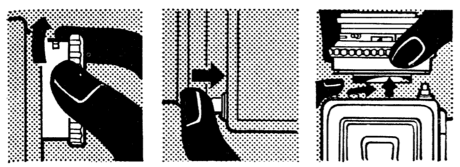
| |
Removing the lens from the Hasselblad 500C. First tension the shutter (left). then depress the lens catch (centre), and turn the lens anti-clockwise and lift out of the camera (right).
| |
To fit the lens, mount on the camera so that the red marks on the lens and body are in line (left), then turn the lens clockwise (centre). The tensioning shafts on both the camera and the lens must have their groove lined up with the red dot before a lens can be fitted (right). This is automatically the case if the camera is always tensioned before a lens is removed or fitted.
|
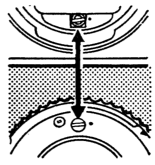
|
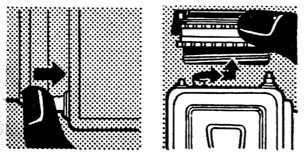
To remove the lens on the F models press the catch (left) and turn the lens anticlockwise to lift out (right).
|
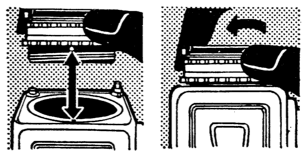
To fit a lens on the F models, line up the red dot on the rear of the lens mount with the red dot on the camera (left). Place the lens in position and turn clockwise to lock (right).
|
|
Interchangeable Finder and Focusing Attachments
The standard reflex hood of the Hasselblad 500C, 1600F and 1000F can be removed. For this purpose the magazine has to be released. You can then slide the hood backwards out of its grooved fitting.
As an alternative there is available a magnifying hood, the eye-level pentaprisms, or the prism sports finder, which is now discontinued. These are pushed into the grooves above the ground glass screen from the back. Push the unit home until it clicks into place.
THE MAGNIFYING HOOD carries in its top a 2.5 x magnifier, which is adjustable by rotating the focusing holder. This provides a range of eyesight corrections equivalent to - 3 to + 3.5 dioptres to suit individual needs. The rubber eyepiece excludes extraneous light.
THE EYE-LEVEL PRISM FINDER has a soft rubber eyepiece with an extra groove to accept an eyesight correction lens. The side of the prism finder carries a release button which permits changing of magazines, as with this finder in position the normal magazine release button is inaccessible. The finder provides a brilliant upright and right-way-round image, magnified 2½ times, with camera at eye-level.
THE EYE-LEVEL PRISM FINDER NC-2 is similar to the above but has a sighting angle of 45 degrees and gives a three-times magnification.
THE PRISM SPORTS FINDER fits into the grooves above the ground glass in place of the reflex hood. It is made of stainless steel and light alloy. It has two sighting apertures. The first is for looking straight ahead through the front frame to observe and follow the subject. The second eyepiece is directed down at approximately 25 degrees into a tube. At the end of the latter there is a pentaprism above a small rectangular centre-section of the reflex ground glass screen. This permits focusing and control of the depth of field while the camera follows the subject. The tube is adjustable and marked for parallax correction. The front frame has a spring-loaded holder for interchangeable masks. A mask for the 2¼ x 2¼ in. negative size is supplied with the finder. Separate masks for the 16 and 16S magazines are available. Each mask has in its centre a polarized disc which appears blacked out if the eye is not in a straight line with the front frame.
THE TIRAC SPORTS FINDER is a simplified version of the above sports finder. It is suitable for the model 500C. It has parallax correction but no reflex focusing prism, and it can be folded flat. The film fits into the accessory shoe. The metal frame is used as a mask for the standard 80-mm. Planar lens with the 2¼ x 2¼ in. magazine. Masks for different picture sizes and lens fields slide into the grooved metal frame.
THE SPORTS FINDER F is of similar design to the Tirac, but for the 1600F and 1000F. The base contains the flash socket for either the U.S. or the standard 3-mm. co-axial flash plug.
THE FRAME FINDER TISFC shows the field of the 150-mm. and 250-mm. lenses and clips to the front of the lens hood.
The Ground Glass Adapter
A ground glass adapter can be attached to the back of the Super Wide models in the same way as a magazine. When working from a tripod, the ground glass screen permits visual observation of the image, for easy composition, alignment of vertical lines and control of depth of field. The screen is fitted with a Fresnel lens for brighter images.
The ground glass adapter can be combined with the magnifying hood or the standard reflex hood of any of the other Hasselblad models.
|
ALTERNATIVE FINDER UNITS

To remove the standard hood (left), first release the magazine 6 and then slide the hood backwards out of its grooved fitting. Alternative finders, such as the magnifying hood (right) can then be slid in place.

To fit the pentaprism, first remove the sheath from the bottom of the pentaprism which protects the optical glass surfaces. Mount the pentaprism on the top of the camera in the same way as the standard hood (left). Alternatively the prism frame finder (now discontinued) can be fitted on the top of the camera. This simultaneously provides a view of the focusing screen and a direct eye-level view through the frames of the finder. Interchangeable masks are available for the finder frame to indicate the fields of view with the different lenses (right).

The sports viewfinder (left) fits into the shoe in the side of the camera. This finder again can be fitted with interchangeable masks for lenses of different focal length. A special version indicates the fieId of view for the Sonnar 150 and 250 lenses used with Hasselblads 500C/500EL and magazines A12, 12, 24 or 70.
The Super Wide C can also be used with a ground glass adaptor (right) to permit precise focusing on a ground glass screen. The adaptor fits in place of the film magazine, and can be used with the focusing magnifier for accurate judgement of the screen image.
|
CLOSE-UP EQUIPMENT
The Hasselblad camera is particularly suitable for close-up photography as the actual picture is seen on the ground glass screen right up to the moment of exposure. This eliminates all parallax and focusing errors. Any of the Hasselblad lenses can be used for close-ups.
Without the aid of any attachments the 80-mrn. Planar focuses down to 3 ft. At this distance the lens covers an area of 19 3/4 x 19 3/4 in. With the 60-, 150- and 250-mm. lenses at their closest setting the field covered is even somewhat less (see table on page 63). If smaller areas are to be photographed, there are various close-up accessories.
Proxar Lenses
These are Zeiss close-up lenses in double bayonet mounts for series attachments (adding further a Proxar lens or/and a filter). They fit the front of the 80-mm. Planar f2.8 lens. There are three types: Proxar 1.0 (focusing range 22 7/16 to 42½ in.), Proxar 2.0 (26 2/3 to 83 3/4 in.), and Proxar 0.5 (17¼ to 24¼ in.). They can be used singly or in combination.
When working with close-up lenses, stop down the camera lens to at least f 4 or f 5.6, to avoid falling-off of definition towards the corners. No change of exposure time is required.
Extension Tubes
These go between the lens and the camera body. They increase the lens-to-film distance and thus enable the lens to focus on much closer distances.
FOR THE HASSELBLAD 500C two extension tubes are available. One is 21 mm. long (M21) and one 55 mm. (M55). They have bayonet front and rear fittings to suit the 500C body and lenses. A shaft passes through the extension tube to connect the camera lens with the mechanism of the body, thus permitting the same automatic aperture control as without extension tubes. They can be used in conjunction with any of the Hasselblad 500C lenses. For instance, with the 80-min. lens and the M21 tube the focusing range covers subject-film distances from 40.2 to 48.5 cm.; with the 80-mm. lens and the M55 tube, from 31.9 to 32.6 cm.
With the standard 80-mm. Planar lens, extension tubes can also be used in conjunction with the Proxar lenses.
Before fitting the extension tubes fully wind the film transport and remove the lens. Attach the tube first to the camera body, and the the lens to the tube. If two tubes are used, first fit the M21 to the camera body, the M55 tube to the M21 tube, and finally the lens to the front of the combination of tubes.
To remove the extension tube or tubes, first remove the lens from the extension tube, releasing it with the extension tube release button. Then remove the extension tubes, one at a time, starting with the route tube.
FOR THE HASSELBLAD F MODELS two tubes are provided. One is 20 mm. long (No. 20) and one 40 mm. (No. 40). They are threaded to fit the camera body on one end and the lens on the other. They are suitable for all Hasselblad 1600F and 1000F lenses and can be used individually or in combination.
|
CLOSE UP GEAR
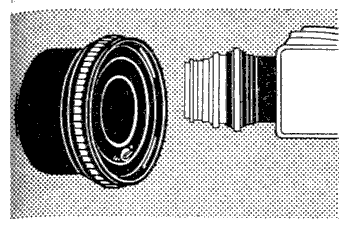
Extension tubes are available for the Hasselblad to go between the camera and the lens and shutter unit of the 500C. The tubes can be used with any of the lenses. and incorporate a coupling shaft to con. nect the shutter tensioning and automatic aperture control system of the lens to the camera mechanism. The tubes must thus be fitted in the same way as the lenses, with the coupling shaft lined up with the red dot inside the tube.
Similar tubes, but without the coupling system are available for the F models.
|
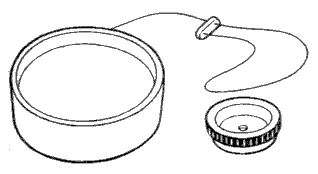
The linear mirror unit is used in photocopying when extremely accurate parallel alignment between the plane and subject is essential. It is accurate to within two minutes of arc.
|
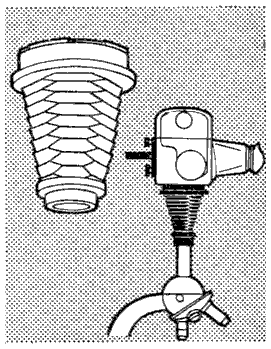
The micrometer adaptor connects the Hasselblad directly with the eyepiece of the microscope for photomicrography.
|
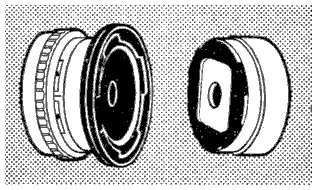
A special microscope shutter is available to fit between the camera and the micro adaptor (left). This has no lens, and merely pro vides a means of controlling the exposure . Alternatively the rear auxiliary shutter of the camera can be used. A lens mount adaptor is also available for certain special lenses on the camera (right)
|
|
Extension Bellows
The extension bellows for the Hasselblad acts in the same way as the tubes but provides a valuable extension between 3 in. and 8 in. It is intended for large close-ups, macrophotography, and copying of small originals (e.g. postage stamps).
The bellows unit for the Hasselblad 500C has bayonet mounts for attachment to the camera and to take the lenses. It is supplied with a double cable release for the operation of the lens and the camera mechanism. The lens is tensioned manually with a setting arm in the lens mount on the bellows unit. A lens-hood front adapter is used in conjunction with the attachment. This adapter is essential when working with the transparency copy holder (see below).
The bellows unit for Hasselblad 1600F and 1000F is similar to that of the Hasselblad 500C, but it has a screw mount for the 1600F/1000F lenses and does not employ the double cable release. (The lens and camera mechanisms on these models are independent from each other.)
Assembling the Extension Bellows
- Remove the front bellows-hood.
- Screw the red cable of the twin cable release into the cable socket on the lower front, and the other cable into the corresponding one on the back of the bellows unit. (This applies only to the bellows for the model 500C.)
- Remove the camera lens from the body. Fit it (with the red dot of the lens lined up with the red dot on the bellows unit) to the front of the unit. Mount the rear of the bellows (again lining up the red dots) on the camera body. (With the bellows unit for the Hasselblad F models, screw the lens to the bellows and the bellows to the camera.)
- Slide the front hood into the front tube of the unit. But first loosen the locking screw on the side of the tube.
- Clip the rear ring of the bellows hood to the front bayonet mount of the lens and tighten the retaining screw on the rear of the bellows hood unit.
Using the Extension Bellows
As the automatic tensioning system is disconnected when the bellows attachment is in use, the shutter requires tensioning after each exposure.
Turn the tensioning arm on the front of the attachment through one full turn, Tension the camera by the film transport knob. (On the Hasselblad F models the transport knob in any case tensions the shutter.) Focus with the lower knob on the left-hand side; set the range and scale with the upper knob. Either movement can be locked by the corresponding knobs on the right-hand side of the bellows unit.
The front bellows hood can be extended to the required shading effect by loosening its fixing screw and unclipping the hooks on both sides of the hood.
To expose, depress the cable release button until the auxiliary shutter opens. This means also that the lens shutter is closed and the aperture is set to the preselected opening. Wait with the final releasing until the camera has stopped vibrating and then release fully. Keep the release depressed until the shutter mechanism has run down, otherwise the auxiliary shutter (of the Hasselblad 500C) will close and break the exposure.
|
THE EXTENSION BELLOWS
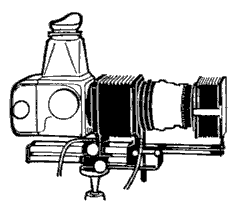
The camera mount connects directly to the body of the Hasselblad. The rear unit is movable and controls the extension of the bellows. Scales on the rails indicate the necessary exposure increase with the various lenses. The lens fits into the front mount on the bellows. A twin cable re lease is used with the bellows, to work the camera re ease and the release of the automatic lens aperture control respectively. The tripod mount moves the whole bellows unit forward and backward on the tripod, to permit accurate focusing without varying the bellows extension.
|
 Assembling the bellows. Remove the front hood (left, fit the cable releases at the front and the rear of the bellows unit (centre left); mount the camera lens in the front mount (centre); replace the extension hood (centre right); and finally mount the camera on the rear mount (right).
Assembling the bellows. Remove the front hood (left, fit the cable releases at the front and the rear of the bellows unit (centre left); mount the camera lens in the front mount (centre); replace the extension hood (centre right); and finally mount the camera on the rear mount (right).
|
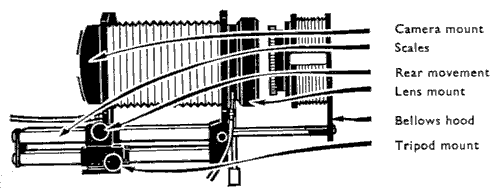
|
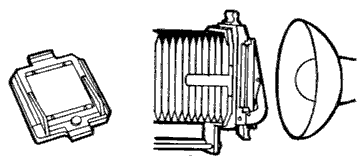
The extension bellows can also be used for copying transparencies with the aid of the transparency copy holder. This fits on the front of the extension hood and takes transparencies (or negatives) which are illuminated from behind by suitable light source.
|
|
The Transparency Copy Holder
This is an attachment which is used in conjunction with the extension bellows and hood. It permits copying of colour negatives and transparencies. You can at the same time correct under-exposure, colour casts, too contrasty or flat colour transparencies. You can also duplicate colour copies or black-and-white ones. Finally, you can use the copy-holder for making colour separation negatives.
To use the copy holder, push it into the grooves on the front of the hood of the assembled extension bellows unit. Attach the support bracket to the bellows with its tripod screw. Release the ground glass screen by the catch on its base, insert the object to be copied and tighten the locking screw above the catch. Focus and set the degree of enlargement. Tighten the support bracket screws and expose.
The Microscope Adapter
This can be attached to the Hasselblad 500C to provide an effective, convenient connection between the camera and the microscope eyepiece. The microscope adapter can be connected either directly to the camera-in which case the exposure is made with the rear shutter in the camera body-or with the microscope shutter especially designed for photomicrography.
The Microscope Shutter
This is an XM-synchronized Synchro Compur shutter with speeds from 1 to 1/500 see. and B. It is tensioned and released automatically and is used in conjunction with the microscope adapter. Use a cable release to avoid vibration. Alternatively, open the rear shutter before the exposure, by pressing the quick-release button. The exposure will then be made by the micro-shutter alone on pressing the release button on the camera.
If the extension bellows is fitted between the microscope shutter and the camera the magnification provided by the microscope lens can be adjusted continuously.
The extension bellows, like the microscope adapter, provides a completely vibrationless microscope attachment. If the focusing hood is used, the microscope image appears directly on the ground glass. The double cable release for the extension bellows then opens the rear auxiliary shutter immediately before the between-the-lens shutter, and so ensures a vibration-free exposure.
A LENS MOUNT ADAPTER is available to connect special lenses such as generally used for photomicrography to the Hasselblad 500C camera.
THE LINEAR MIRROR UNIT permits extremely accurate parallel alignment between film plane and subject in copying. It consists of a lens flange mirror attached in place of the lens of the Hasselblad 500C and a reflecting mirror placed at the subject plane.
A RINGLIGHT can be attached to all Hasselblad 500C lenses, except the 500-mm. It gives even, shadowless illumination in close-up work in research, medicine, technology, etc. It is fitted with cables to connect with Paffrath C Kemper electronic flash units.
|
MISCELLANEOUS ACCESSORIES
The Rapid Winding Crank
The film winding knob of the Hasselblad 500C is interchangeable, and can be replaced by a rapid winding crank. The crank consists of a knob base with bayonet fitting and a handle which can be folded over into the base and is swung outward for use. Cranking the handle advances the film and sets the shutter in one smooth and even movement, reducing the transport time. It is therefore useful for all quickaction work, particularly in sports photography. It is attached and removed in the same way as the winding knob ( # ).
The Winding Knob with Exposure Meter
Suitable for the Hasselblad 500C, this is a precision photo-electric exposure meter incorporated into a film winding knob. It can be fitted to the camera in place of the standard knob and removed from it in the same way as the normal knob ( # ). It can therefore be used on the camera, or for independent exposure readings. The meter is calibrated in exposure values from 1-20 and is fitted with an incident light blind which can be drawn over the photo cell and locked in position by the catch at its end. For normal reflected light measurement, the blind is pushed back.
To use the meter:
- Set the film speed by turning c tie disc in the centre outside face of the meter with a coin until the ASA or DIN film speed marker points to the speed of the film to be used.
- Point the meter at the subject.
- Read off the exposure value and set it on the shutter. Trace from the black or white section against which the needle registers to the corresponding exposure value number on the outside rim of the meter. This is the value to be set.
Detach the exposure meter from the camera when working with the long focus lenses, as the lens branch of the latter may produce reflections which would make the exposure meter reading inaccurate.
CHECKING THE METER. When the cell is completely shielded from all light, the meter needle should point to the white line at the left-hand end of the scale. If it does not, it can be re-set to the zero position by turning the small adjustment screw on the meter rim below the cell.
Exposure Meter Attachment
This attachment can be clipped to the front of the lens hood and holds the exposure meter when using the rapid winding crank on the 500C. It also enables the user of the 500EL to use the exposure meter.
The Exposure Meter Wrist Strap
A wrist strap, now discontinued, with a bayonet fitting similar to that on the camera body holds the Hasselblad exposure meter. This is useful when the rapid winding crank is used on the camera, or when the meter is used separately, e.g. for incident light or close-up readings.
Flash Holder Attachment
The flash holder clips to the lens hood and simplifies use of flash bulbs and flash cubes. It offers additional ways of using the flash as its baseplate can be clicked into different positions.
The Quick Focusing Handle
Designed for extra-fast movement of the lens focusing mount, the handle is made from resilient plastic, and is equipped with three movable index markers and six coloured rubber sleeves. For use the ring is pressed over the focusing ring of the lens mount. The markers can be placed anywhere on the ring and the desired colour sleeves attached to act as focusing position signals.
The quick focusing handle Type 1 is suitable for the 50 and 60-mm. Distagon and 80-mm. Planar lenses of the Hasselblad 500C, while the Type 11 will fit the 120,150 and 250-mm. lenses of the Hasselblad 500C.
The Quick Tripod Coupling
The quick tripod coupling consists of a base plate which is screwed on top of the tripod. The top of the base is grooved. To connect the Hasselblad 500C or Super Wide C to the tripod, simply place the camera on the base and push it home. It is locked into position by a simple turn of the protruding handle on the base.
The quick tripod coupling can also be utilized by Hasselblad models 1600F and 1000F by attaching the shoe FUCUS to the camera.
The Pistol Grip with Release
For convenient holding of the Hasselblad 500C at eye level with the pentaprism or sports finder this grip can be fitted to the quick attachmerit shoe of the 500C. A release trigger on the grip connects to the camera release button. The grip is shaped for the left hand.
The Flash Gun Bracket
This attachment fulfils the function of the camera grip (described above) and is combined with a flash bracket to accept a flash gun or an electronic flash unit in a standard accessory shoe fitting (which is on top of the handle). A cable release is fitted. The unit with camera and flash attached can be held at eye level by the grip. This unit is suitable for the Hasselblad 500C and Super Wide C with the quick tripod coupling. An adjustable flash shoe for the 500C model is designed to hold small flashguns and electronic flash units. It fits the accessory socket of the camera.
The Spirit Level
A spirit level attaches to the accessory socket on the side of the Hasselblad 500C body. The levelling can then be observed from above. This attachment is useful for architectural and other photographs where distortion of vertical lines has to be avoided.
The Checked Screen
This Plexiglass plate can be placed over the ground glass screen and is held in position by the focusing head. It is ruled with vertical and horizontal lines which outline the picture sizes of the 16 and 16S magazines, It is intended to help in the composition of the picture and in aligning vertical and horizontal subjects.
The Cut Film Adaptor
The cut film adapter is usable on all Hasselblad camera models.. It permits taking single exposures on 2½ x 2½ in. cut film or plates to utilize the wide range of emulsions available in these forms.
The cut film adapter is stainless steel outside and diecasting inside; locks and catches are chrome-plated brass. The film holder is nickelsilver treated. It is of course advisable to have a number of holders.
The film holder accepts 2½ x 2½ in. film or plates. As this size is not generally available, cut film has to be cut down to the proper size. For this purpose a special film cutter is available. To use the film cutter, place a 2½ x 3½ in. sheet of film under the cover guard in the cutter so that it touches the two stop plates. (This must be done in total darkness.) The notched edge of the film should be turned inwards. Press the guillotine knife down to trim to the correct size.
Loading the Cut Film Holder
Load the holder in the dark room or in complete darkness with 2½ x 2½ in. (6.5 x 6.5 cm.) cut film. Place the film in the film frame with the emulsion side towards the frame. Fold the frame against the backing plate and press down so that the sheath can be pushed into position. Make sure that the sheath is pushed in all the way. The velvet light trap shuts out all light.
If the backing plate is removed by sliding it away from the film frame, plates can also be used. Insert plates in the same way as the film.
Attaching the Adapter to the Camera
Fit the back to the camera in the same way as the roll film magazine. Push the holder into position on the camera back until it gets blocked by the lock which moves automatically aside. Pull out the sheath completely. You can now expose the film.
After exposing, re-insert the sheath.
The sheet film holder lock prevents the back from being fitted to or removed from the camera when the sheet film holder is in position. The holder fulfils here the same function as the roll film magazine sheath: you cannot release the shutter until the sheath has been withdrawn completely. The holder remains locked in the adapter as long as the sheath is pulled out.
The red knob on the handle of the sheath can be used as an exposure signal.
Polaroid Back for the Hasselblad 500C
This adaptor can be attached to the camera in place of the Hasselblad magazine. The standard 107 black and white or 108 colour pack can be used to provide 8 pictures, the picture size remaining 2¼ x 2¼ in. This back offers a finished print in 15 seconds and is also useful as a check of picture quality, depth of field and lighting.
Command Unit
This unit is intended for simultaneously exposing up to four cameras to release with the same impulse signal. It is operated by a battery in one of the connected cameras. Exposure can be made by impulse signal, cable, tinier or radio.
Underwater Equipment
A range of underwater cases has been designed for Hasselblad cameras. A case for the 500C with prism finder and another for the Super Wide C with viewfinder clamp are available.
|
HASSELBLAD ACCESSORIES
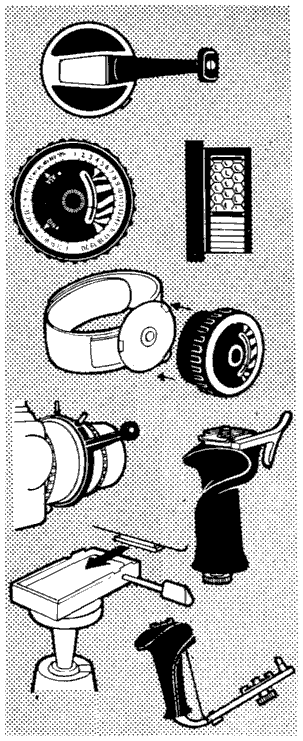
The rapid winding crank fits on the came ra in place of the normal winding knob, for quick film transport and shutter tensioning.
The exposure meter knob is a winding knob with the built-in exposure meter system m. This comprises a meter cell with incident light diffuser, and the measuring instrument which directly reads in exposure values after being set to the appropriate film speed.
The exposure meter knob can also be fitted to a wrist strap as an alternative to mounting it on the camera. This makes separate meter readings more convenient.
Left: The quick focusing handle fits on the lens and carries a series of movable index markers for rapid adjustment of the focusing mount. When the appropriate index marker is on top, you know that the lens is set to a predetermined distance. Right: The camera grip fits the tripod bush in the base of the Hasselblad 500C, for convenient eye-level shooting. The release trigger on the grip directly connects to the camera release button.
Left: The quick tripod coupling permits instant attachment of the models 500C or Super Wide C, without the need for screwing the tripod into the bush in the camera. The coupling remains permanently on the tripod. The coupling can be used with older models by fitting an intermediate shoe.
Right: The camera grip with flash bracket consists of a handle. as well as a holder for a flash gun plus a cable release. It permits a steady hold of the camera with the left hand for eye-level shooting.
|
HASSELBLAD ACCESSORIES
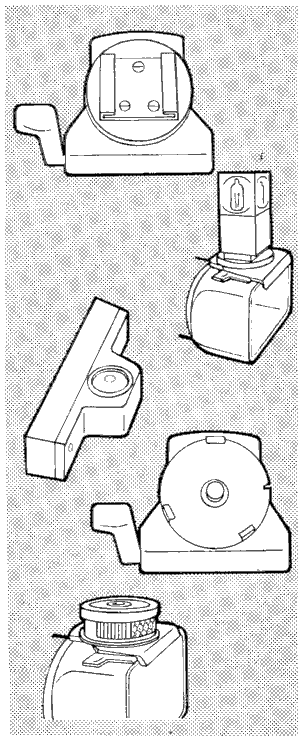
Attachments for flash-holder (top) and exposure meter (bottom) clip on to the front of the lens hood. The flash attachment consists of a swivel plate with a standard accessory shoe to accommodate a small flash gun or flash cube. The attachment for the exposure meter takes the Hasselblad knob with exposure meter, enabling it to be used together with the rapid-wind crank on the 500C and providing a place for it on the 500EL. The spirit level (centre) is particularly useful when short-focus lenses are used. It fits into the accessory socket on the left-hand side of the camera.
|
THE CUT FILM ADAPTOR
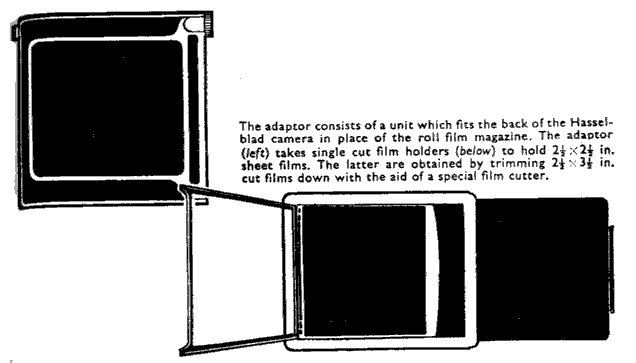
|
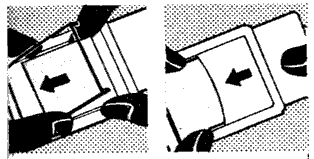
To load the cut film holder place the trimmed sheet of film below the film frame (left), fold down the latter and push in the sheath (right). This must be done in total darkness.
|
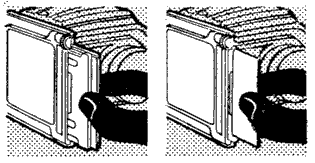
Push the cut film holder into the adaptor from the side (left), then withdraw the sheath ready for exposure (right). After the exposure replace the sheath before removing the film holder.
|
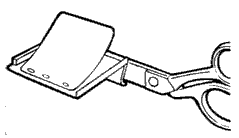
The film cutter cuts down 2½ x 3½ in. sheet films to 2½ x 2½ in. To trim the film, push it under the cover guard so it touches the stop pins. Then trim the film with the built-in scissor blades. This also must be done in total darkness.
|
|
FACTS AND FIGURES
This section gives the more important data for Hasselblad films, exposure, close-up data, etc., in handy tabular form for easy reference.
Conversion of Feet and Inches to Metric Units
Many cameras are marked only in either the metric or Brisith system, while most of the tables in this book are also given in only one system. The table below shows at a glance equivalent lengths.
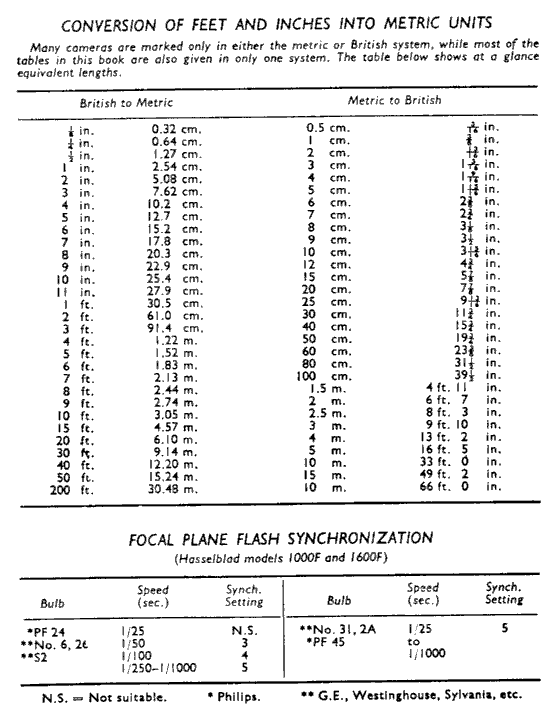
Daylight Exposure Values
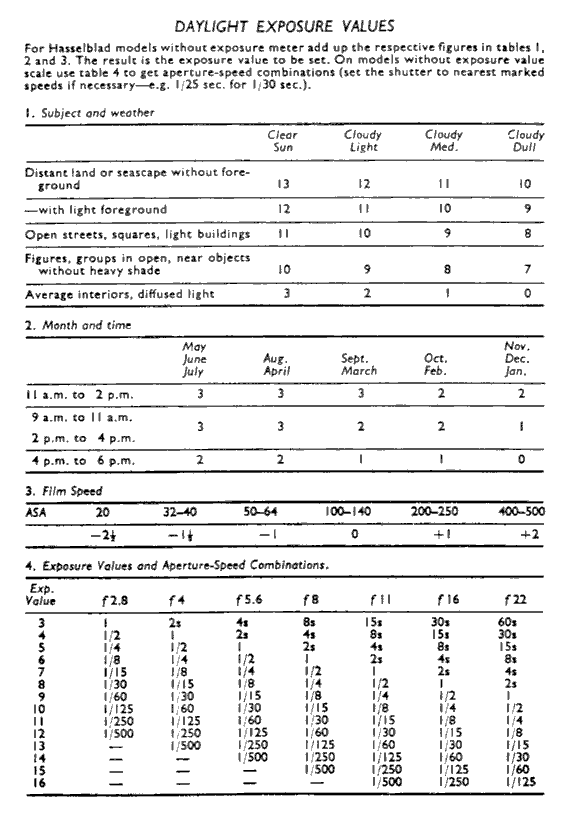
Filters for Black-and-White Film
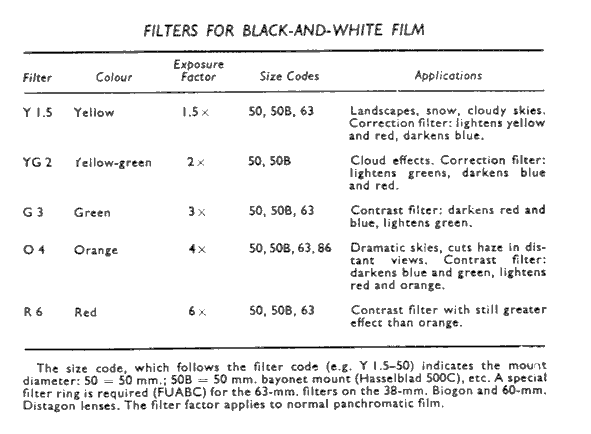
Filters for Black-and-White and Colour Film
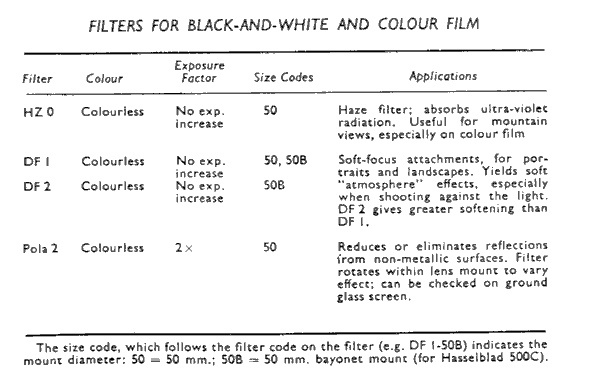
Light Balancing Filters for Reversal Colour Film
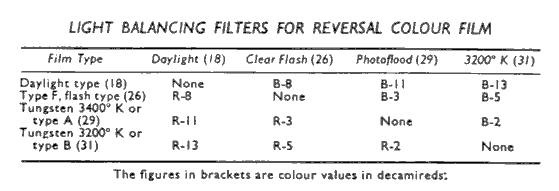
Colour Temperatures and Light Sources
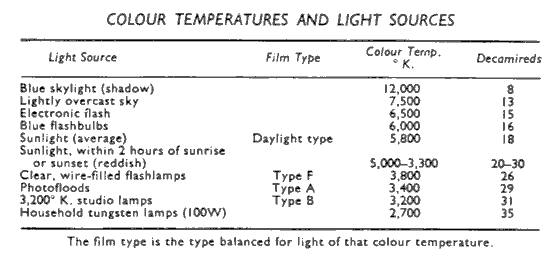
Light Balancing Filter Data
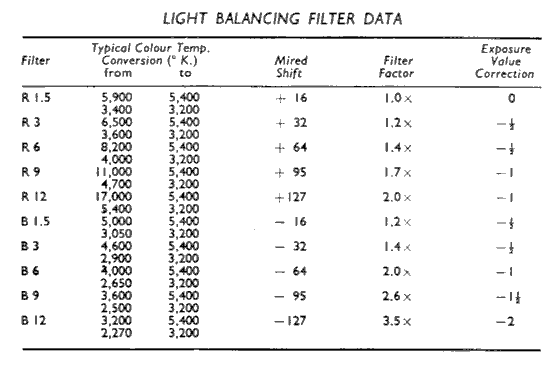
Filter Equivalents
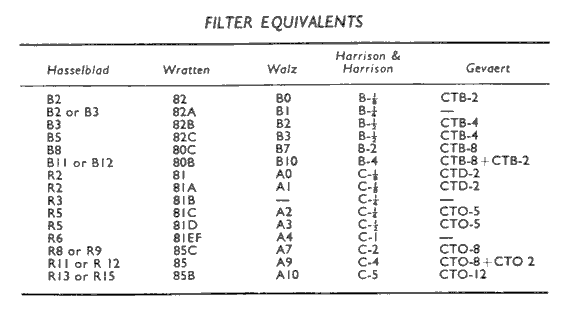
Minimum Focus Range without Accessories
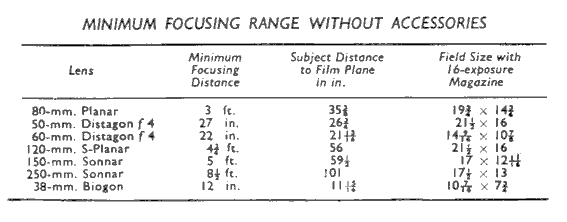
Focusing Ranges ith the 80-mm. Planar and Proxars
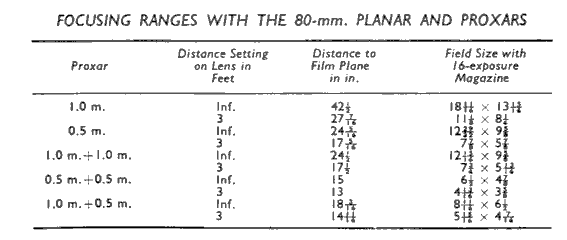
Focusing Ranges with Extension Tubes
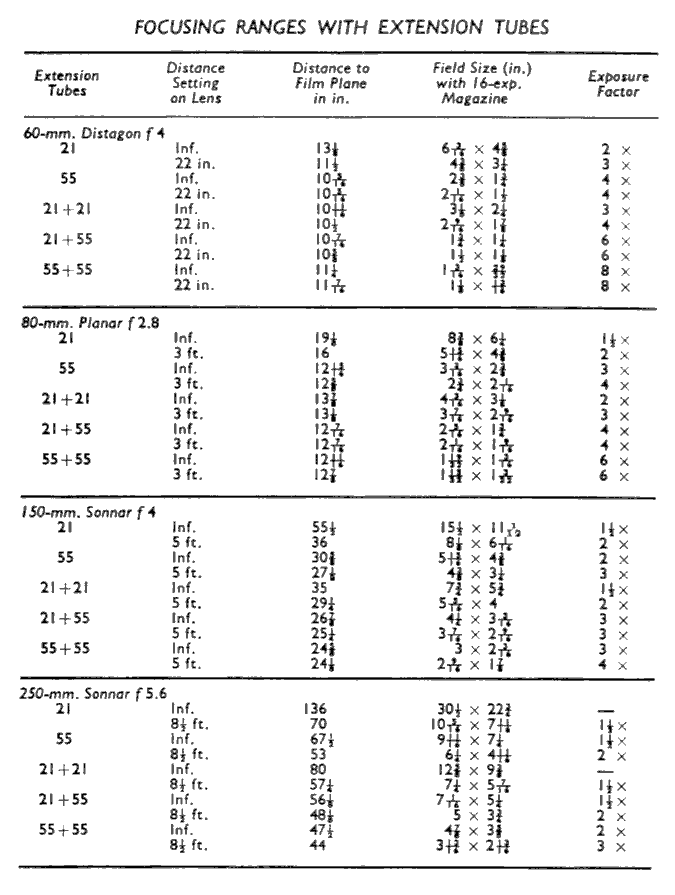
Close Ranges with 50, 60-mm. Distagon and Planar 80-mm.
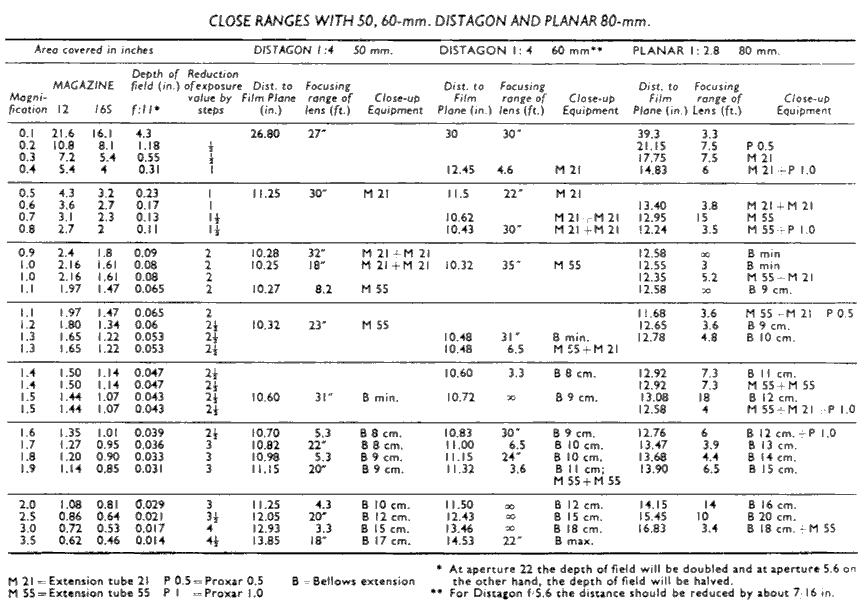
Close Ranges with 120mm, S-PLANAR; 150, 200-mm, SONNAR
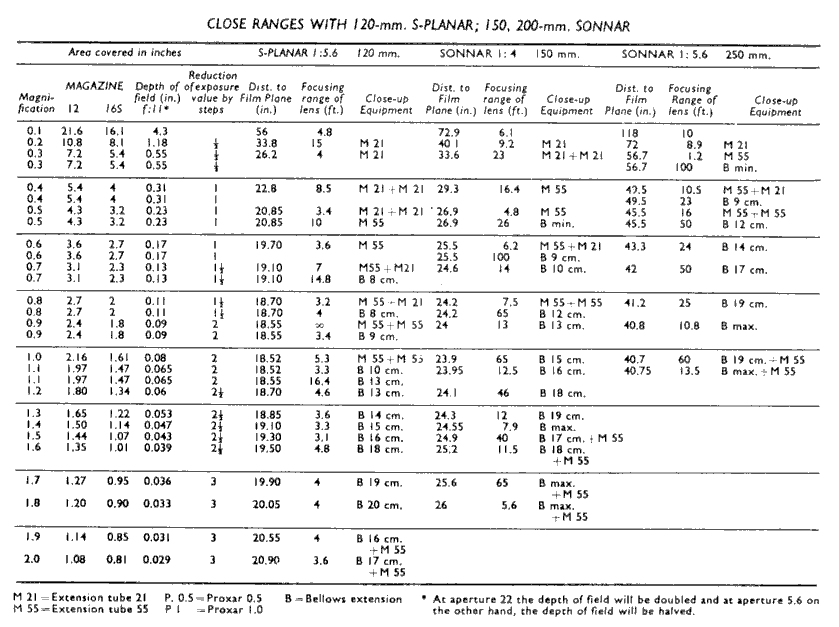
Focusing Ranges with the Extension Bellows
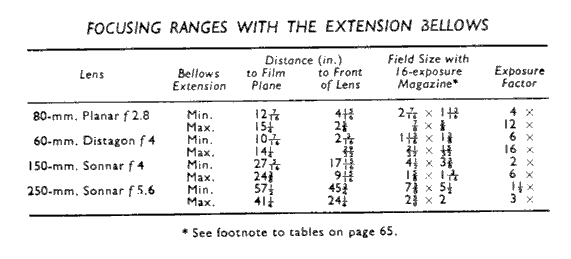
Shutter Speeds to Arrest Movement
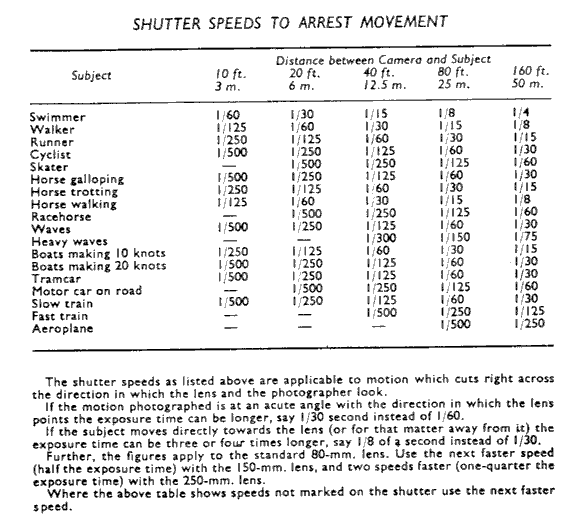
Conversion of Film Speed Systems
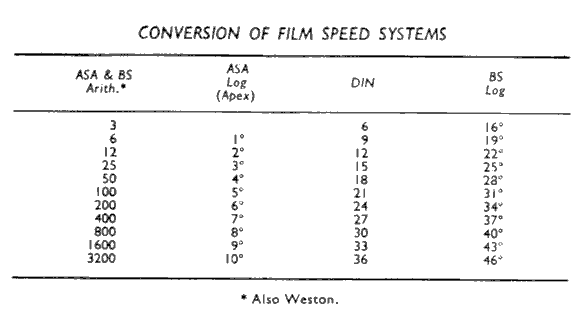
Colour Films
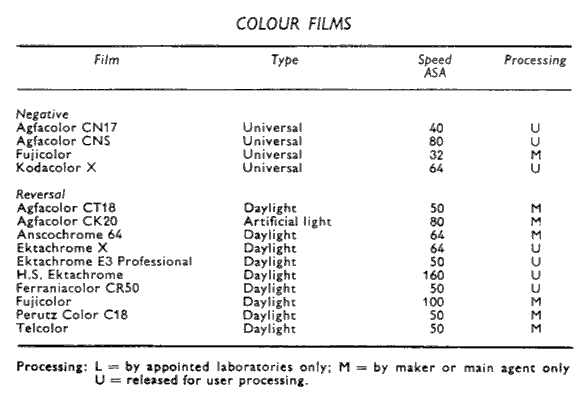
Black-and-White Films
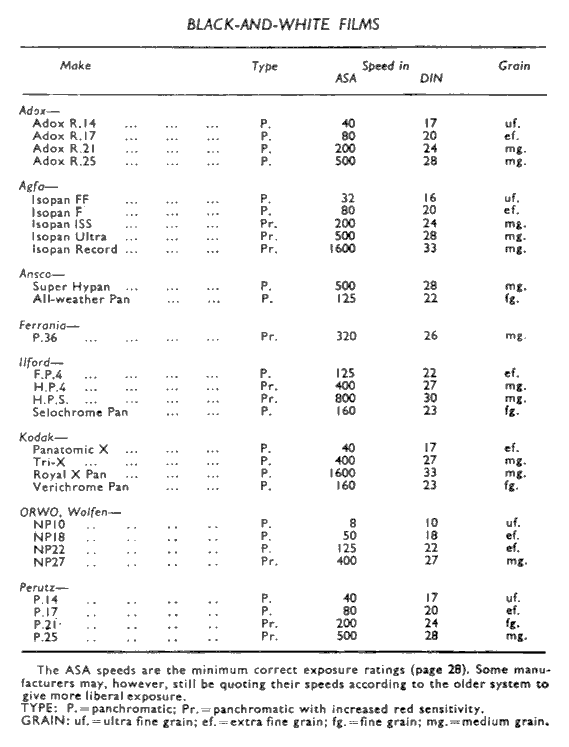
|
The Focal ENCYCLOPEDIA of PHOTOGRAPHY
2,400 articles: 1 3/4 million words
1,936 pages, 450 photographs, 1,750 diagrams
Revised edition
Price £10 10s.
Two-volume set
THE FOCAL ENCYCLOPEDIA will do the job of a whole library. These two volumes hold the right answers to any question on photography - ready for prompt reference. They contain more information than many books put together. Much of it could not easily be found elsewhere. A great deal of it has never before been published
THE FOCAL ENCYCLOPEDIA covers completely the vast technology of photography and follows up all its uses for picture making. It defines terms, identifies personalities and quotes rules. It recalls past developments and records the present state of progress all over the world. It sums up scientific theory and instructs in up-to-date practice.
THE FOCAL ENCYCLOPEDIA is specially written in plain, readable and commonsense English. It was carefully planned and set out in alphabetical order for easy reference. You will be able to find, instantly master and put to good use, all the information you need from whatever angle you look for it.
THE FOCAL ENCYCLOPEDIA can take the place of a photographic library: and no library is complete without it.
See it at your bookseller's or photographic dealer's or write for prospectus to Focal Press.
|
 Download
Download
Download this guide in Acrobat PDF format for easy printing.
|